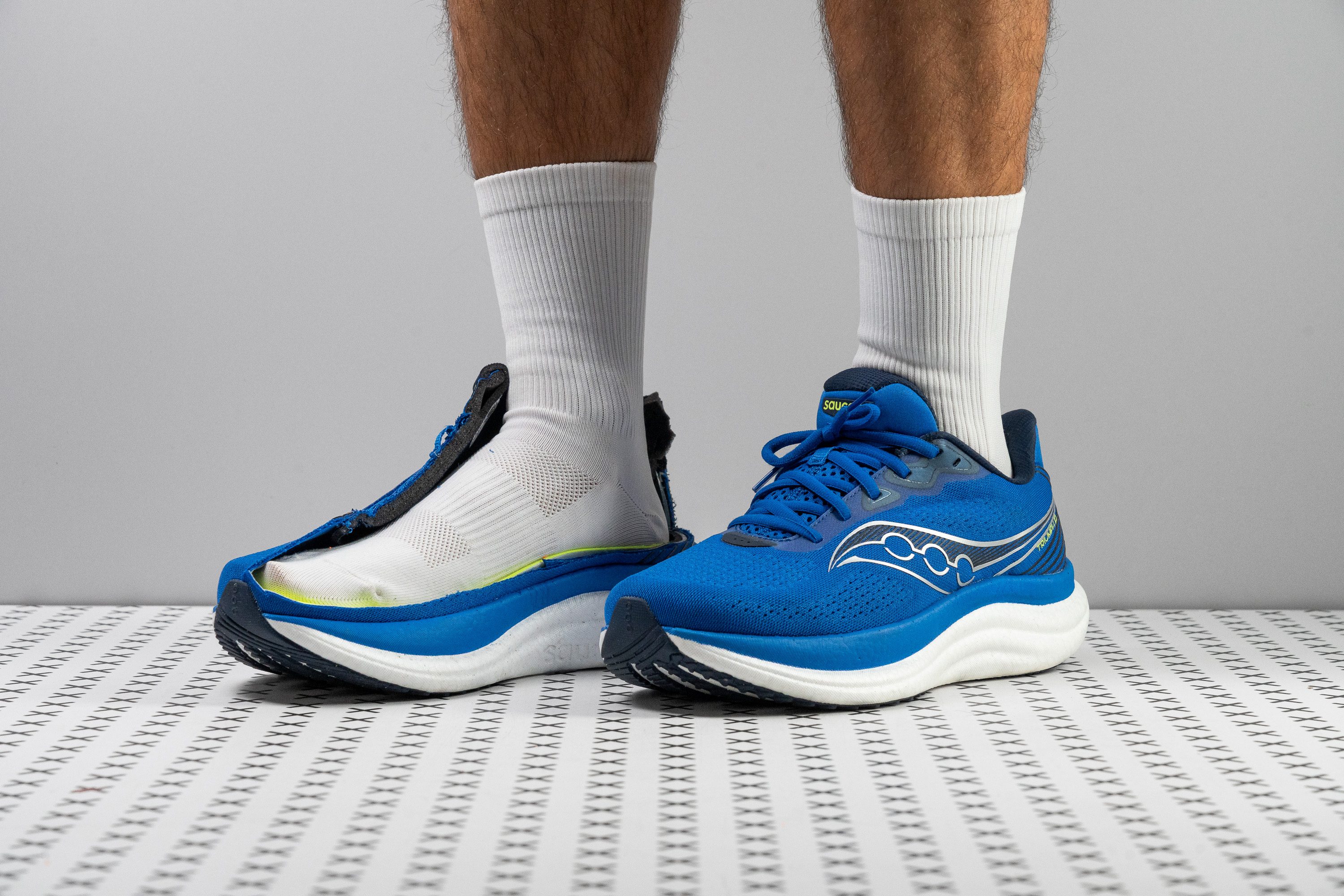Nuestra conclusión
Pros
- Muy buen retorno de energía
- Más ligeras que la versión anterior
- Muy amortiguadas para las distancias largas
- Plataforma ancha que las hace muy estables
- Mediasuela totalmente de PWRRUN PB
- Plantilla de primera calidad
- Estructura duradera en general
- Lo suficientemente versátiles para el uso diario
- Rendimiento constante cuando hace frío
- Muy buen agarre
Contras
- Ahora son más caras
- La transpirabilidad podría mejorar
- La PWRRUN PB puede ser firme para algunos
- El diseño grandote las hace menos ágiles
Veredicto de los usuarios
- Top 25% entre Zapatillas de running para asfalto
- Top 25% entre zapatillas de running neutras
- Top 22% más vendidas zapatillas de running
Comparativa
Las zapatillas de running más parecidas
+ + Añadir unas zapatillas | |||||
|---|---|---|---|---|---|
| Puntuación global | 89 Notables | 91 Excelentes | 76 Aceptables | 92 Excelentes | |
| Precio | 190 € | 170 € | 150 € | 160 € | |
| Pace | Correr a diario | Correr a diario | Correr a diario | Correr a diario | |
| Absorción de impactos | Alta | Alta | Alta | Alta | |
| Retorno de energía | Alto | Alto | Bajo | Alto | |
| Tracción | Alta | Moderada | Alta | Alta | |
| Arch support | Neutral | Neutral | Neutral | Neutral | |
| Peso laboratorio Peso marca | 9.6 oz / 272g 9.3 oz / 263g | 10.2 oz / 289g 10.1 oz / 285g | 10.2 oz / 289g 10.1 oz / 286g | 8.7 oz / 248g 8.6 oz / 245g | |
| Lightweight | ✗ | ✗ | ✗ | ✓ | |
| Drop laboratorio Drop marca | 10.0 mm 10.0 mm | 9.6 mm 10.0 mm | 10.4 mm 10.0 mm | 10.3 mm 8.0 mm | |
| Técnica de carrera | TalónMedio/antepié | TalónMedio/antepié | Talón | Talón | |
| Talla | Tallan bien | Tallan bien | Tallan un poquito grande | Tallan un poquito grande | |
| Rigidez de la mediasuela | Equilibrada | Blanda | Blanda | Equilibrada | |
| Diferencia de la rigidez de la mediasuela en frío | Pequeña | Pequeña | Normal | Pequeña | |
| Durabilidad de la parte delantera | Decente | Decente | Decente | Mala | |
| Durabilidad del acolchado del talón | Alta | Alta | Alta | Media | |
| Durabilidad de la suela exterior | Buena | Buena | Buena | Decente | |
| Transpirabilidad | Media | Media | Media | Media | |
| Anchura / ajuste | Media | Media | Media | Estrecha | |
| Anchura de la parte delantera | Media | Media | Estrecha | Estrecha | |
| Flexibilidad | Rígida | Rígida | Moderada | Moderada | |
| Rigidez torsional | Moderadas | Rígidas | Moderadas | Rígidas | |
| Rigidez del contrafuerte del talón | Rígido | Moderado | Rígido | Flexible | |
| Talón laboratorio Talón marca | 42.3 mm 37.0 mm | 42.3 mm 45.0 mm | 36.2 mm 36.5 mm | 42.2 mm 40.0 mm | |
| Antepié laboratorio Antepié marca | 32.3 mm 27.0 mm | 32.7 mm 35.0 mm | 25.8 mm 26.5 mm | 31.9 mm 32.0 mm | |
| Anchuras disponibles | EstándarAncho | EstándarAnchoExtra Ancho | EstrechoEstándarAnchoExtra Ancho | Estándar | |
| Orthotic friendly | ✓ | ✓ | ✓ | ✓ | |
| Estación | Todas las estaciones | Todas las estaciones | Todas las estaciones | Todas las estaciones | |
| Removable insole | ✓ | ✓ | ✓ | ✓ | |
| Clasificación | #83 Top 23% | #21 Top 6% | #343 7% inferior | #10 Top 3% | |
| Popularidad | #81 Top 22% | #3 Top 1% | #14 Top 4% | #102 Top 28% |
Quién debería comprárselas
Creemos que las Saucony Triumph 23 son estupendas para:
- Los fans de Saucony a los que les decepcionó la versión 22, ya que esta actualización mejora en todos los puntos clave.
- Los runners que están buscando unas zapatillas confiables para las tiradas largas de más de 1 hora y media. Estas son ideales gracias a su gran retorno de energía y a su excelente absorción de impactos.
- Los que están buscando unas zapatillas de entrenamiento diario premium con un upper duradero, una suela exterior con un buen agarre y una pisada con rebote.
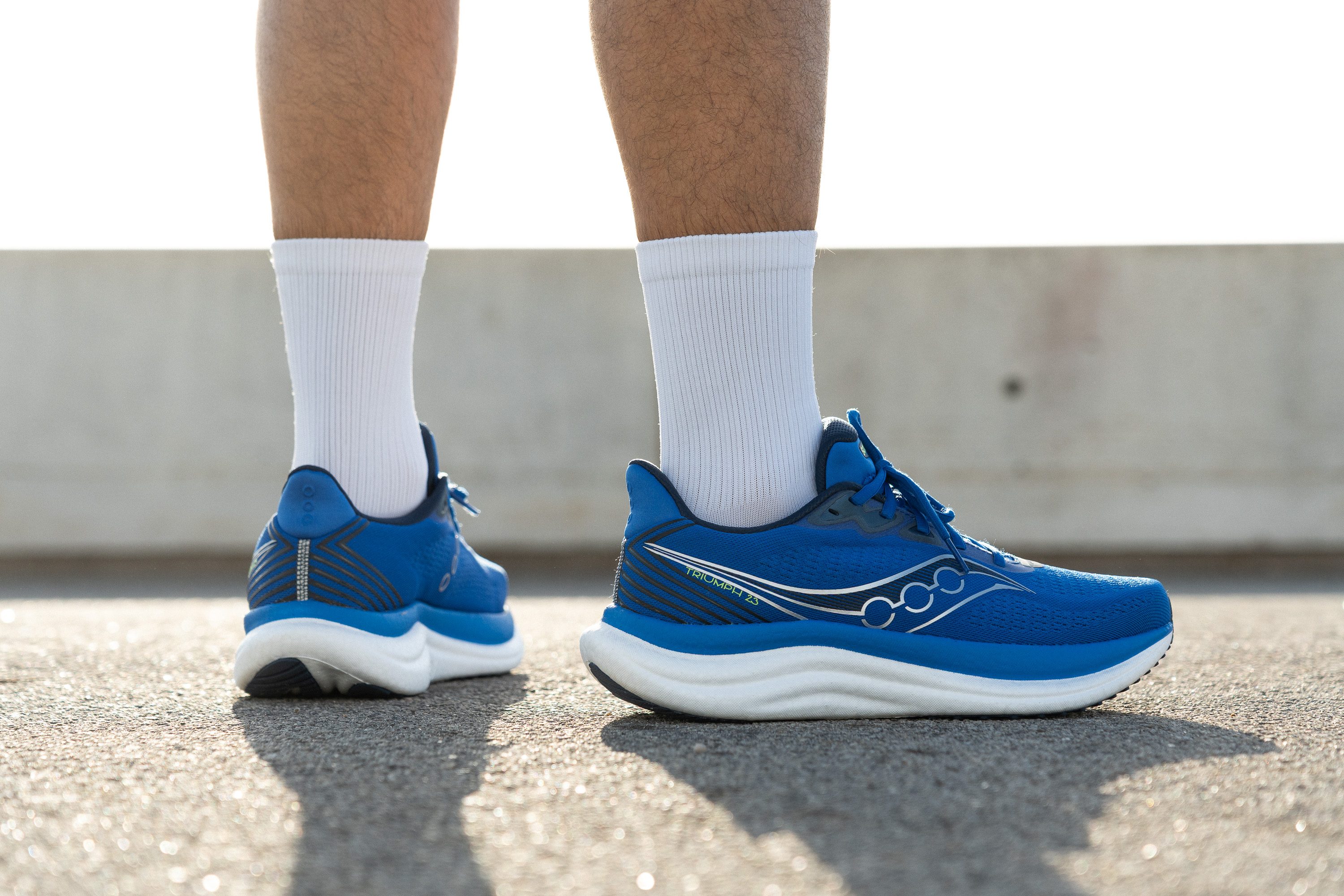
Quién NO debería comprárselas
Creemos que las Triumph 23 no son la mejor opción para los corredores a los que no les gustan de las zapatillas grandes. En nuestra experiencia, se han ido volviendo más voluminosas con cada actualización. Así que, si prefieres una sensación más clásica, las Adidas Supernova Rise 2 son una opción menos grandota pero de alta calidad para el entrenamiento diario.
También creemos que la espuma PWRRUN PB no es algo que vaya a enamorar a todo el mundo. En nuestras pruebas, descubrimos que se siente firme bajo los pies, así a los fans de las mediasuelas mullidas... no les va a hacer mucha gracia. Si lo que estás buscando es algo blandito, las New Balance Fresh Foam X More v6 son unas zapatillas con amortiguación máxima. También tienes las Nike Vomero Plus, que ofrecen una pisada más equilibrada, aunque se inclinen más por una sensación blandita bajo los pies.
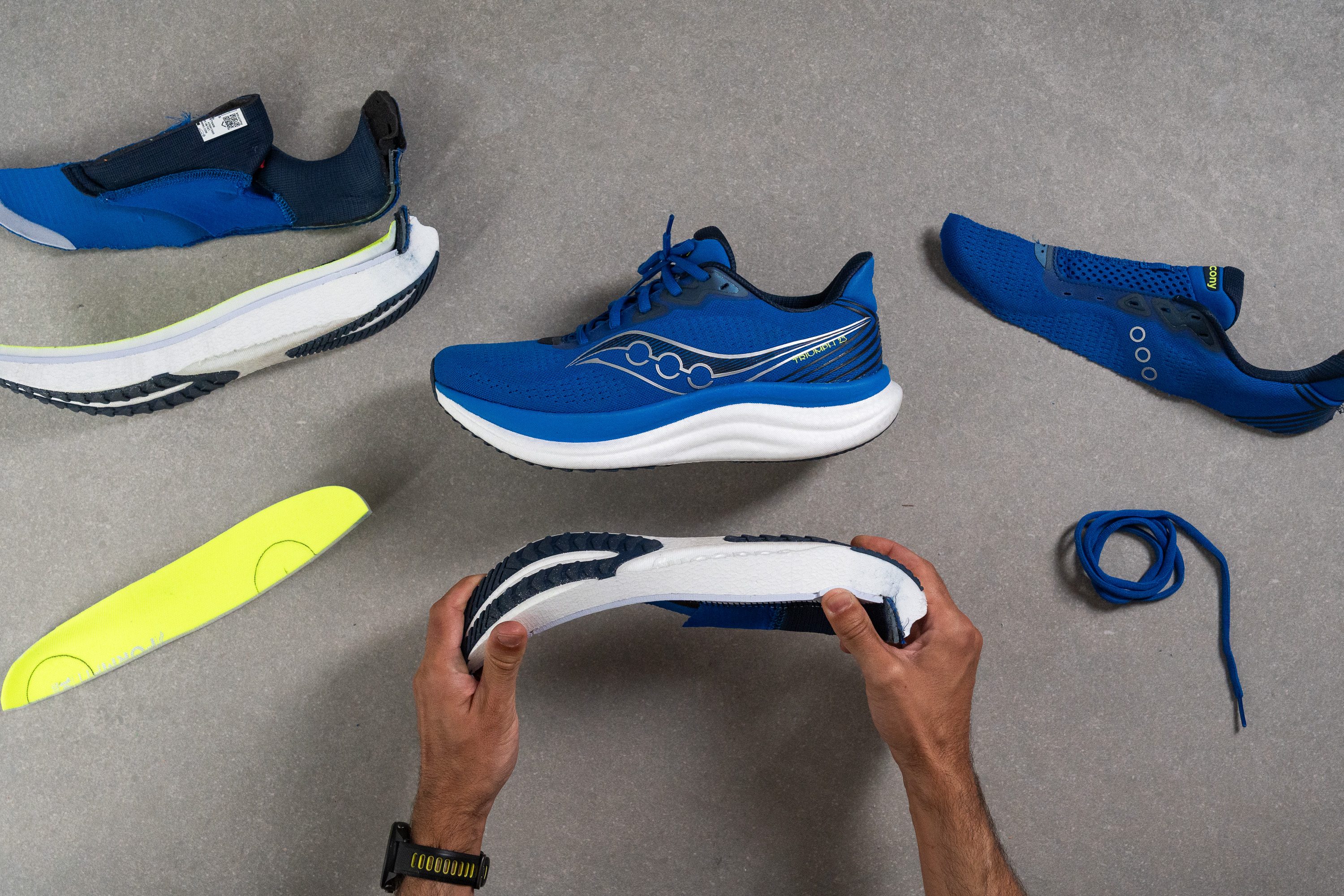
Amortiguación
Shock absorption
A primera vista, puede parecer que las Triumph 23 tienen menos amortiguación que las Triumph 22. Pero las apariencias engañan, así que lo mejor es que te fíes de los datos de nuestro laboratorio. Esto pasa por el diseño de la mediasuela y por cómo están puestos los colores en las zapatillas. Así que, sí, la versión 23 tiene una absorción de impactos bastante mejor.
Nuestra máquina marcó un increíble resultado de 149 SA en el talón y 136 SA en el antepié. Aunque la primera cifra solo es 9 SA más alta que la versión anterior, el antepié la mejora en 15 SA. Esto hace que estas Saucony sean una de las opciones más protectoras para los corredores que aterrizan primero con el antepié.
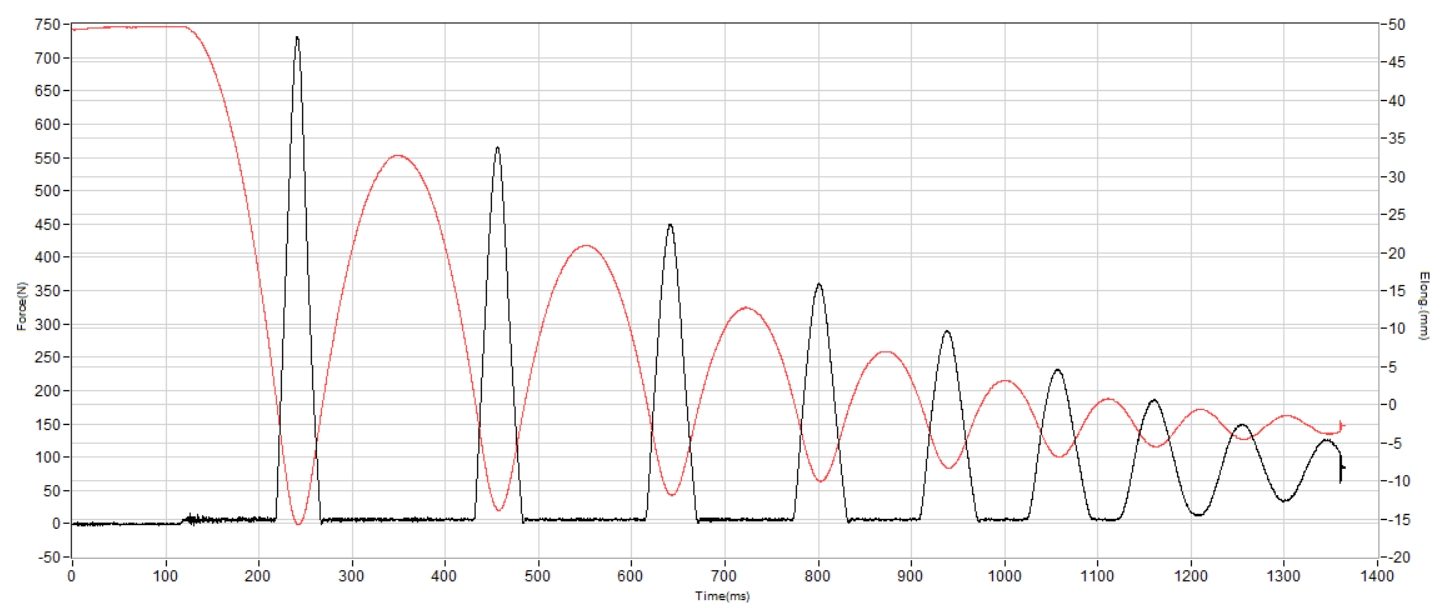
| Triumph 23 | 149 SA |
| Media | 129 SA |
Energy return
Una de las cosas que señalamos sobre las Triumph 22 fue que, incluso con todo el hype sobre que estaban diseñadas totalmente con PWRRUN PB de Pebax, su retorno de energía no es nada del otro mundo. De hecho, ¡descubrimos que algunas espumas de EVA ofrecían un mejor rendimiento!
Pero ahora esto ya no es así. Con un retorno de energía del 67,6 % en el talón y del 71,2 % en el antepié, estas zapatillas están cargadas de energía, y destacan como uno de los mejores modelos de entrenamiento diario si estás buscando rebote y reactividad.
| Triumph 23 | 67.6% |
| Media | 58.5% |
Altura de la suela en la zona del talón
En su ficha técnica oficial, Saucony dice que las Triumph 23 tienen una suela alta, de 37/27 mm; pero cuando la medimos nosotros, nos dio un resultado totalmente distinto. La verdad es que nos llevamos una sorpresa, ya que cuando medimos las suelas, nuestro calibre suele marcar resultados más bajitos de lo que dicen las marcas, pero en este caso nos pasó lo contrario.
Nuestros calibres marcaron 42,3 mm cuando medimos la altura de la suela en el talón, así que las Triumph 23 han conseguido colarse en el territorio maximalista, eliminando cualquier posibilidad de sentir el suelo bajo los pies. Esto hace que sean perfectas para los corredores que están buscando una amortiguación infinita.
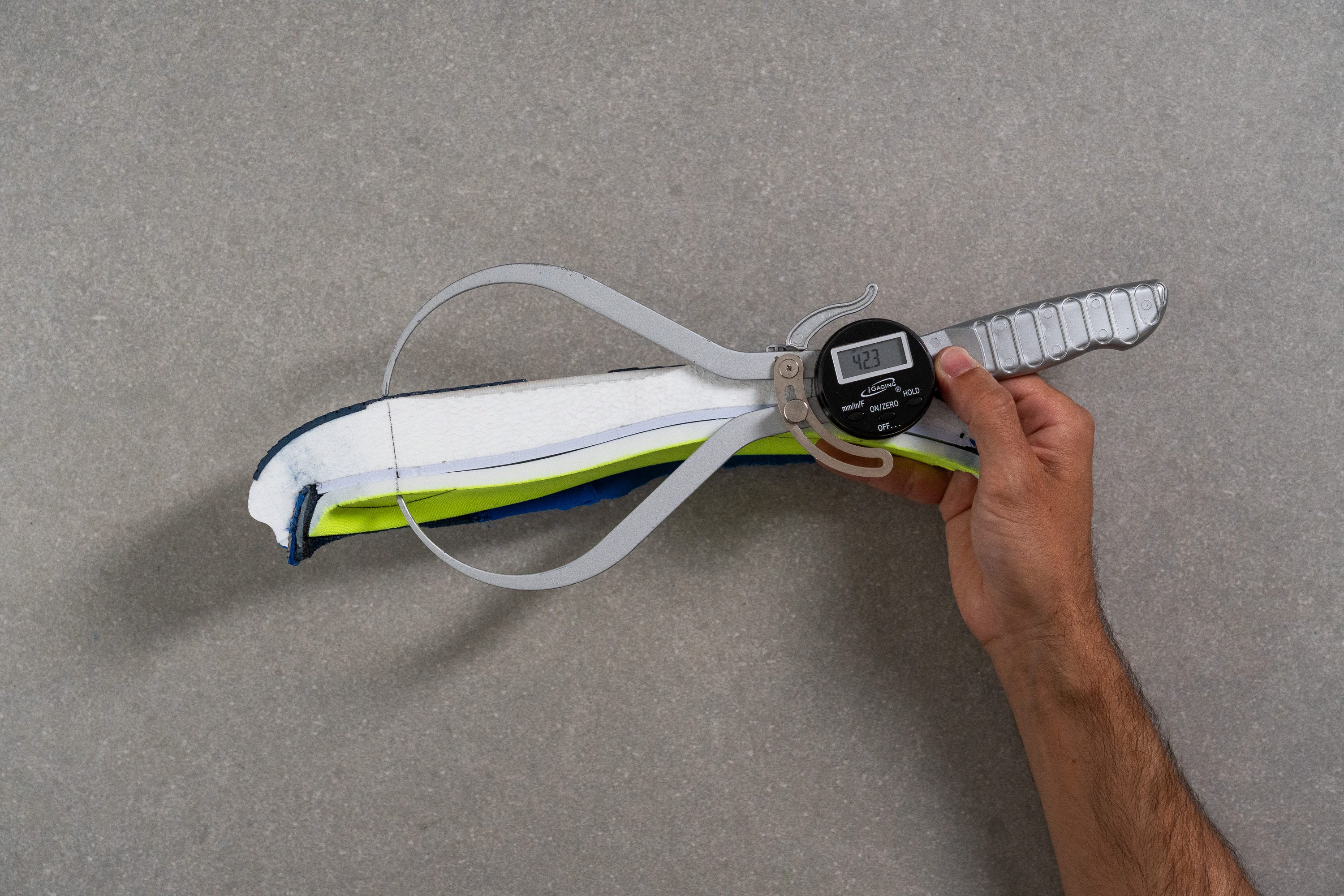
| Triumph 23 | 42.3 mm |
| Media | 34.8 mm |
Altura de la suela en el antepié
Descubrimos una diferencia parecida en el antepié, que alcanza unos 32,3 mm en lugar de los 27 mm anunciados, así que podemos decirte lo mismo que antes sobre esta zona.
Este resultado es un ejemplo perfecto de por qué en RunRepeat disfrutamos tanto de nuestro trabajo. Sin no hubiésemos cortado ni medido las zapatillas, tanto tú como nosotros seguiríamos pensando que tienen una suela de solo 27 mm en el antepié y 37 mm en el talón. ¡Nada más lejos de la realidad!
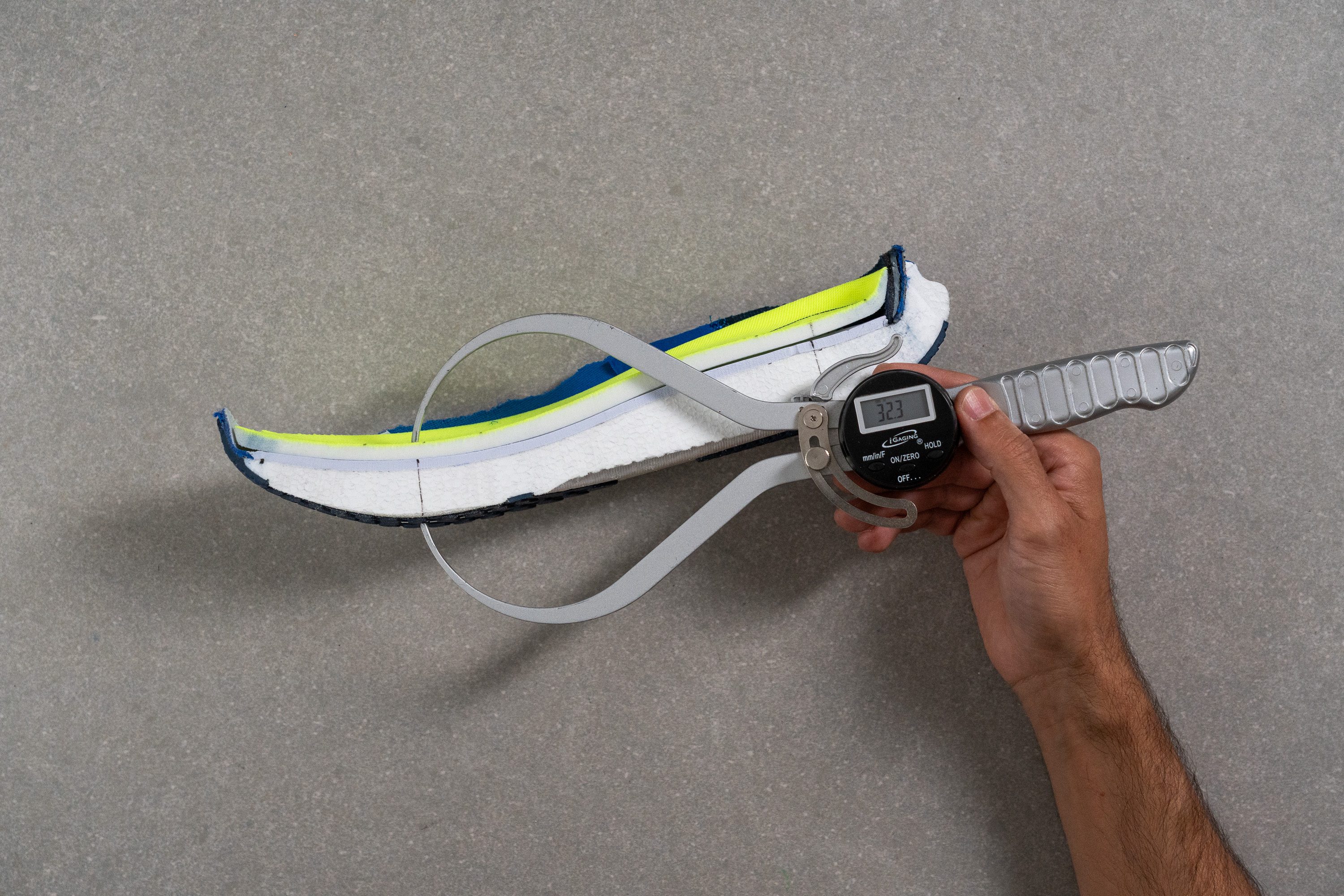
| Triumph 23 | 32.3 mm |
| Media | 26.2 mm |
Drop
Aunque la altura oficial de la mediasuela es bastante diferente de su altura real, Saucony acertó con el drop de 10 mm, ya que en el laboratorio nos encontramos con exactamente el mismo resultado.
Esto hace que las Triumph 23 tengan un drop estándar para unas zapatillas de entrenamiento diario, ya que 10 mm es la cifra que más le gusta a muchas marcas, ya que es ideal para los talonadores. No obstante, nosotros creemos que un drop de 8 mm podría haber sido más versátil.
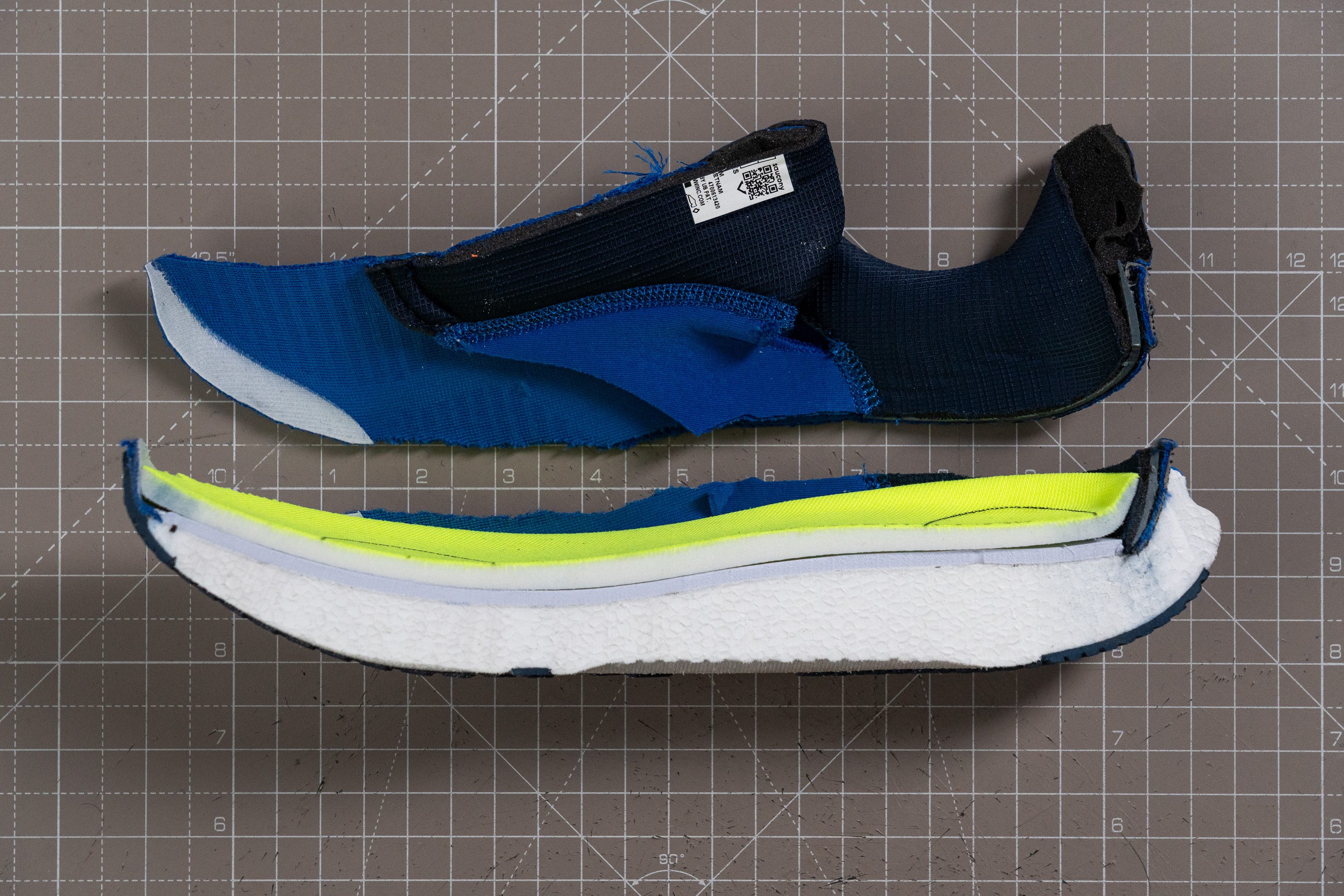
| Triumph 23 | 10.0 mm |
| Media | 8.6 mm |
Suavidad de la mediasuela
Con el tiempo, nos hemos dado cuenta de que la PWRRUN PB es una de esas espumas reactivas con las que no sientes inmediatamente que tengan rebote, aunque sí lo tengan. La sensación es bastante parecida a lo que muchos de nosotros sentimos con las Adidas Adizero Adios Pro 3 en comparación con otras superzapatillas.
Y eso es lo que pasa con las Triumph 23. Como tienen una espuma que es más bien firme (25,5 HA según nuestro durómetro), no nos proporcionó el rebote explosivo de otras alternativas, como la ZoomX o incluso la IncrediRUN de Saucony (que hemos visto en las Endorphin Trainer).
Eso sí, aunque no tiene ese rebote, sigue ofreciendo una pisada llena de energía que destaca en las distancias largas, donde la combinación de una sólida absorción de impactos y un retorno de energía constante marca la diferencia.
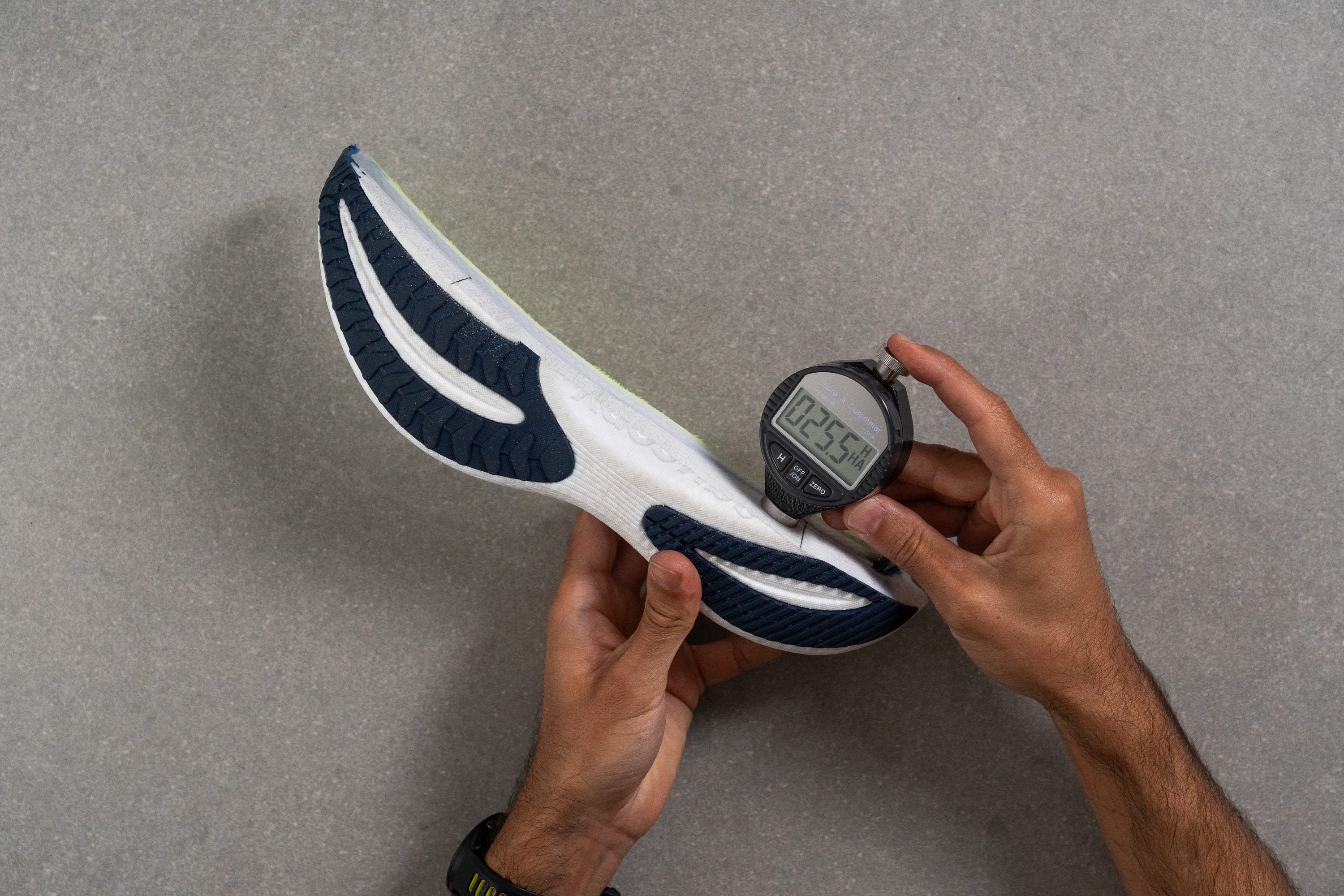
| Triumph 23 | 25.5 HA |
| Media | 20.4 HA |
Rocker
Descubrimos que las Saucony Triumph 23 tienen un rocker que mejora las transiciones, ya que reduce la necesidad de que el antepié se flexione, aunque se activa un poco más tarde en comparación con el de las superzapatillas modernas.
Este diseño gradual en el talón también funciona estupendamente con el drop de 10 mm, creando una plataforma que les va como anillo al dedo a los talonadores.
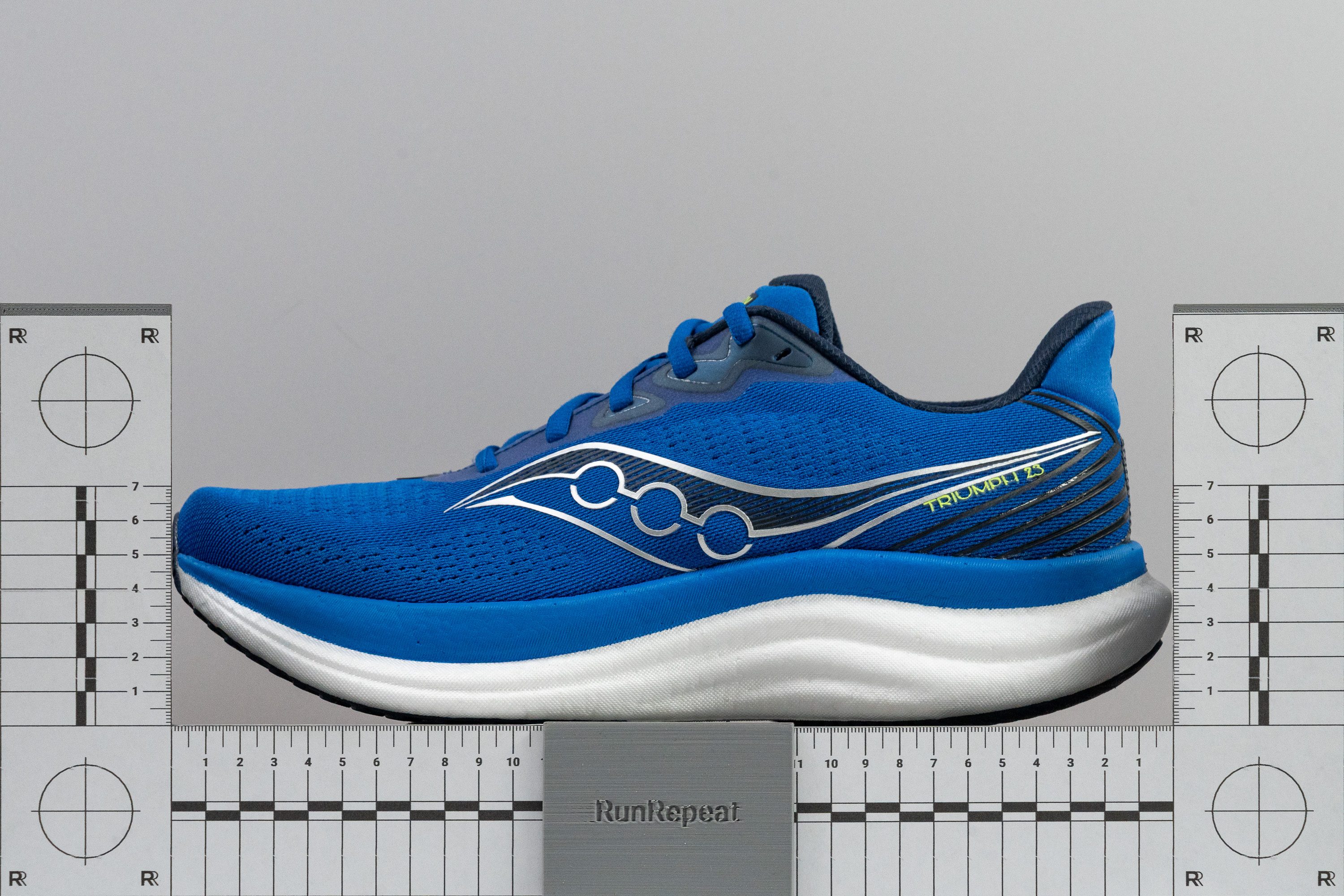
Tallaje y ajuste
Talla
Las Saucony Triumph 23 tallan bien (17 votos).
Anchura / Ajuste
Saucony ha sido algo inconsistente a lo largo de los años con el ajuste: mientras que algunos modelos eran espaciosos, otros tenían una estructura más ajustada. Y eso es lo que pasa con las Triumph 23, ya que Saucony dio un paso atrás y las hizo más estrechas que el del año pasado.
Cuando analizamos el molde de gel que les hicimos, nuestro calibre marcó 93,8 mm, un resultado que está por debajo de la media y que confirmó nuestras primeras impresiones.
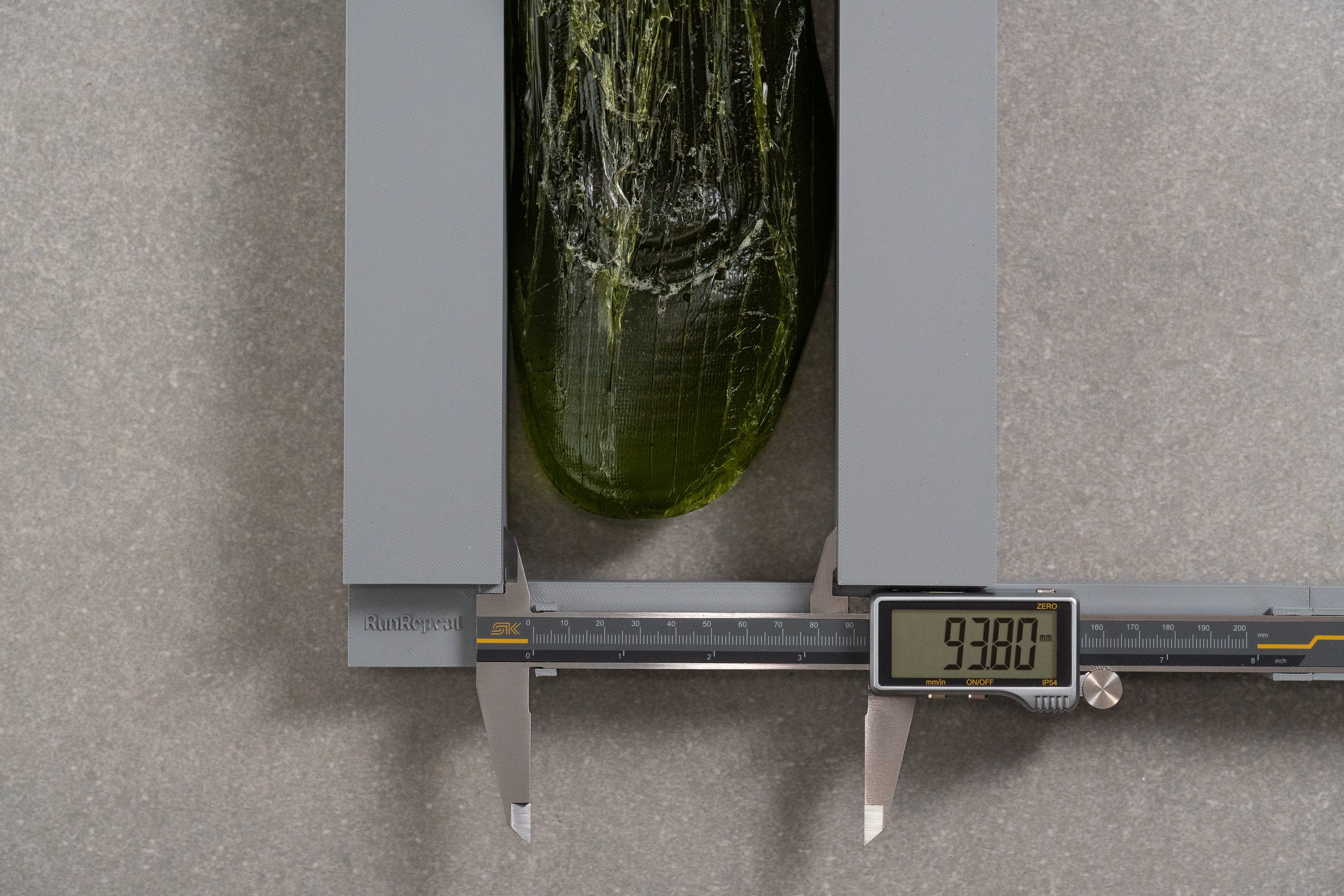
| Triumph 23 | 93.8 mm |
| Media | 95.1 mm |
Anchura de la parte delantera
Con 71,4 mm en la zona del dedo gordo, creemos que se adaptan bien a la mayoría de los corredores, pero son incluso mejores para los que tienen los pies finitos o los que prefieren un ajuste ceñido.
Saucony también ofrece este modelo en tallas anchas en algunos países, como Estados Unidos. La verdad es que es una buena solución si necesitas unos milímetros extra.
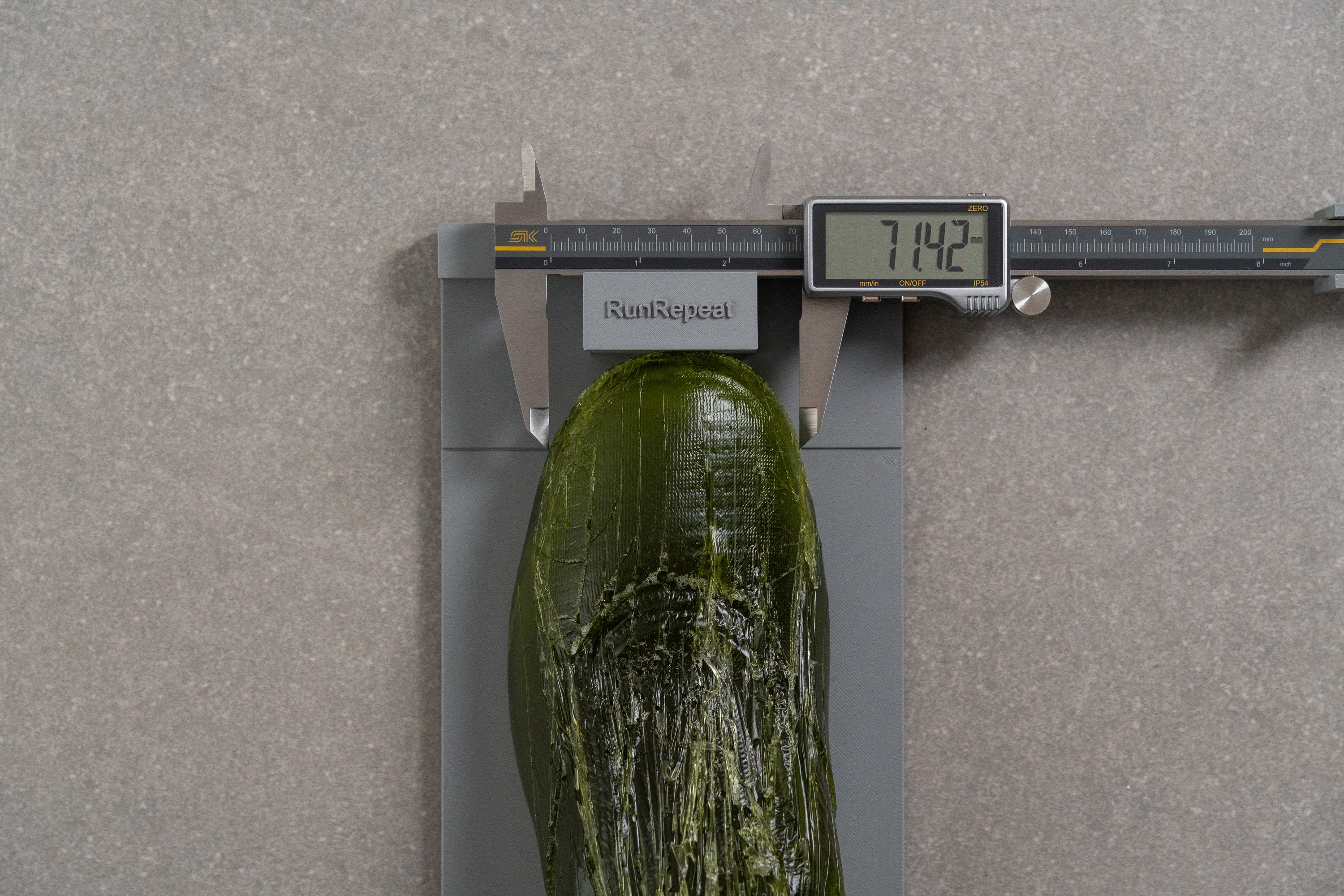
| Triumph 23 | 71.4 mm |
| Media | 73.3 mm |
Altura de la parte delantera
Cuando medimos el espacio vertical, nuestro calibre marcó 26,8 mm, que es un resultado que encaja perfectamente con lo que se espera de unas zapatillas de entrenamiento diario.
En nuestra opinión, las Triumph 23 ofrecen suficiente espacio vertical para la mayoría de los pies.
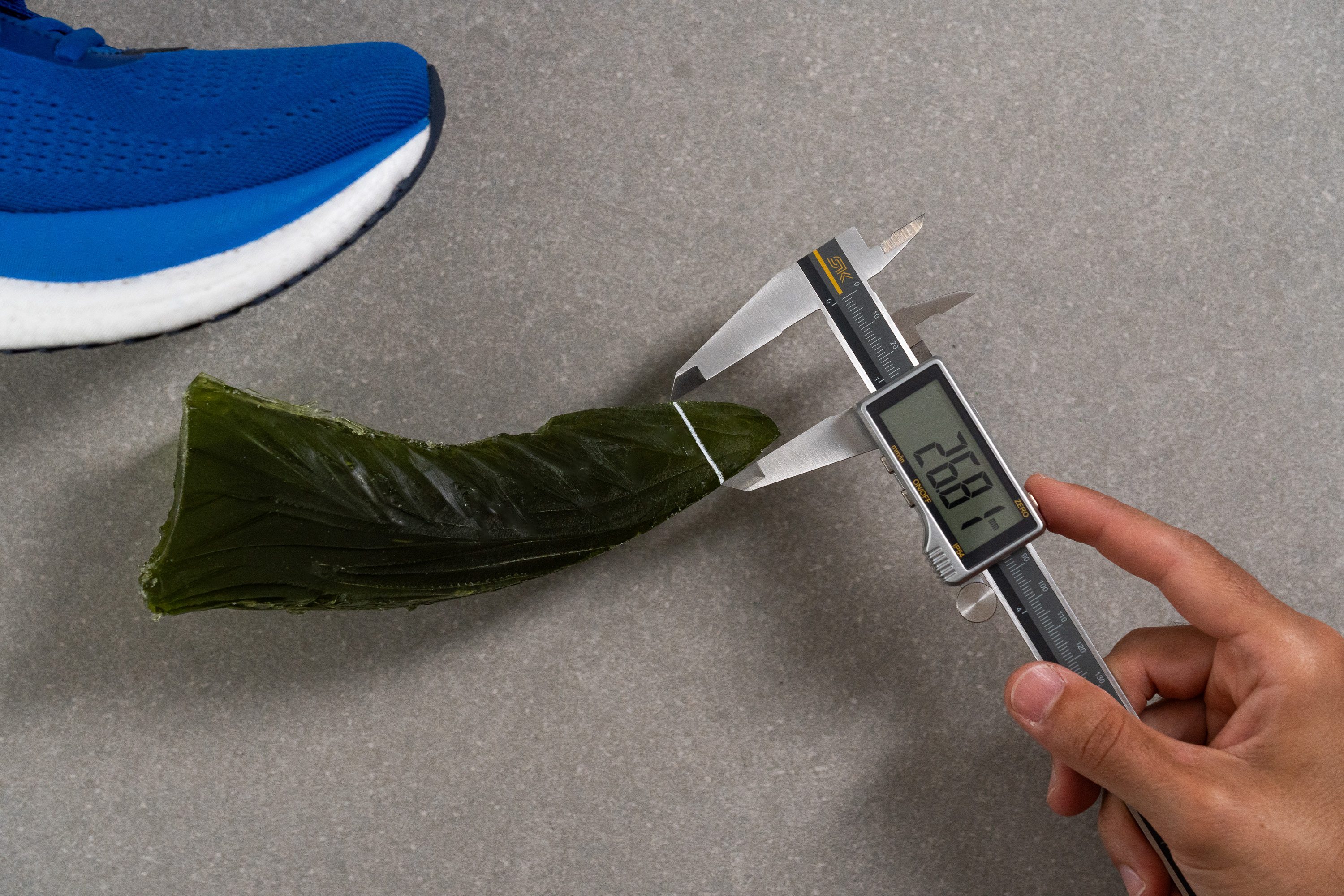
| Triumph 23 | 26.8 mm |
| Media | 27.1 mm |
Tracción / Agarre
Traction test
Una de las cosas en las que teníamos grandes esperanzas de mejora con respecto a la versión 22 era la tracción. A ver, no podemos decir que sea un desastre, pero... la verdad es que tampoco nos pareció nada del otro mundo para un modelo de entrenamiento diario de alta gama. Sinceramente, queríamos algo mejor.
Y Saucony cumplió. Incluso sin mucho caucho en la suela exterior, el dibujo agresivo y el nuevo compuesto generan una tracción muy firme que obtuvo una puntuación de 0,62 en nuestra prueba, lo que hace que sean una opción fantástica para los corredores que se suelen enfrentar a superficies resbaladizas, como la lluvia o el rocío matutino.
| Triumph 23 | 0.62 |
| Media | 0.48 |
Diseño de la suela exterior
La suela exterior de las Saucony Triumph 23 combina zonas con caucho negro con partes expuestas de PWRRUN PB, que es una espuma que ya ha demostrado ser muy resistente a la abrasión en zapatillas como las Endorphin Speed 5. En la parte delantera, vimos que tienen 3 piezas verticales de caucho separadas por canales de espuma, con tacos profundos que mejoran el contacto con el suelo y la estabilidad en diferentes superficies.
Saucony, queremos darte la enhorabuena, porque con nuestro análisis cada vez nos queda más caro que os habéis esforzado mucho con esta suela. Está muy lejos del diseño simple que vimos en las Triumph 22, y cada sección refleja un diseño trabajado y muy bien pensado.
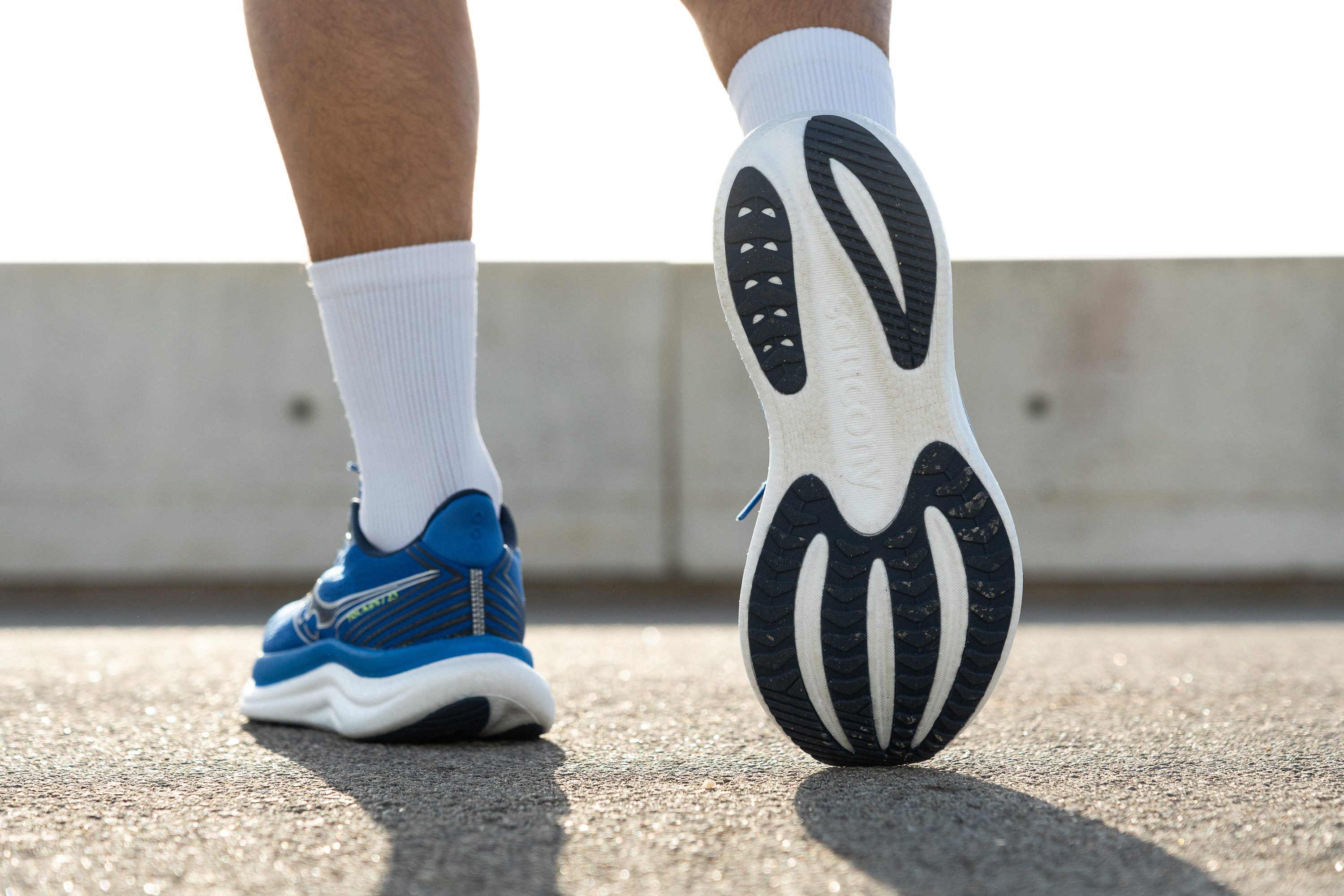
Flexibilidad / Rigidez
Con un resultado de solo 17,4 N, este modelo tiene rigidez estándar, y la verdad es que nos los esperábamos. Eso sí, no la sentimos prácticamente nada ni al correr ni antes de poner estas Saucony en nuestra máquina.
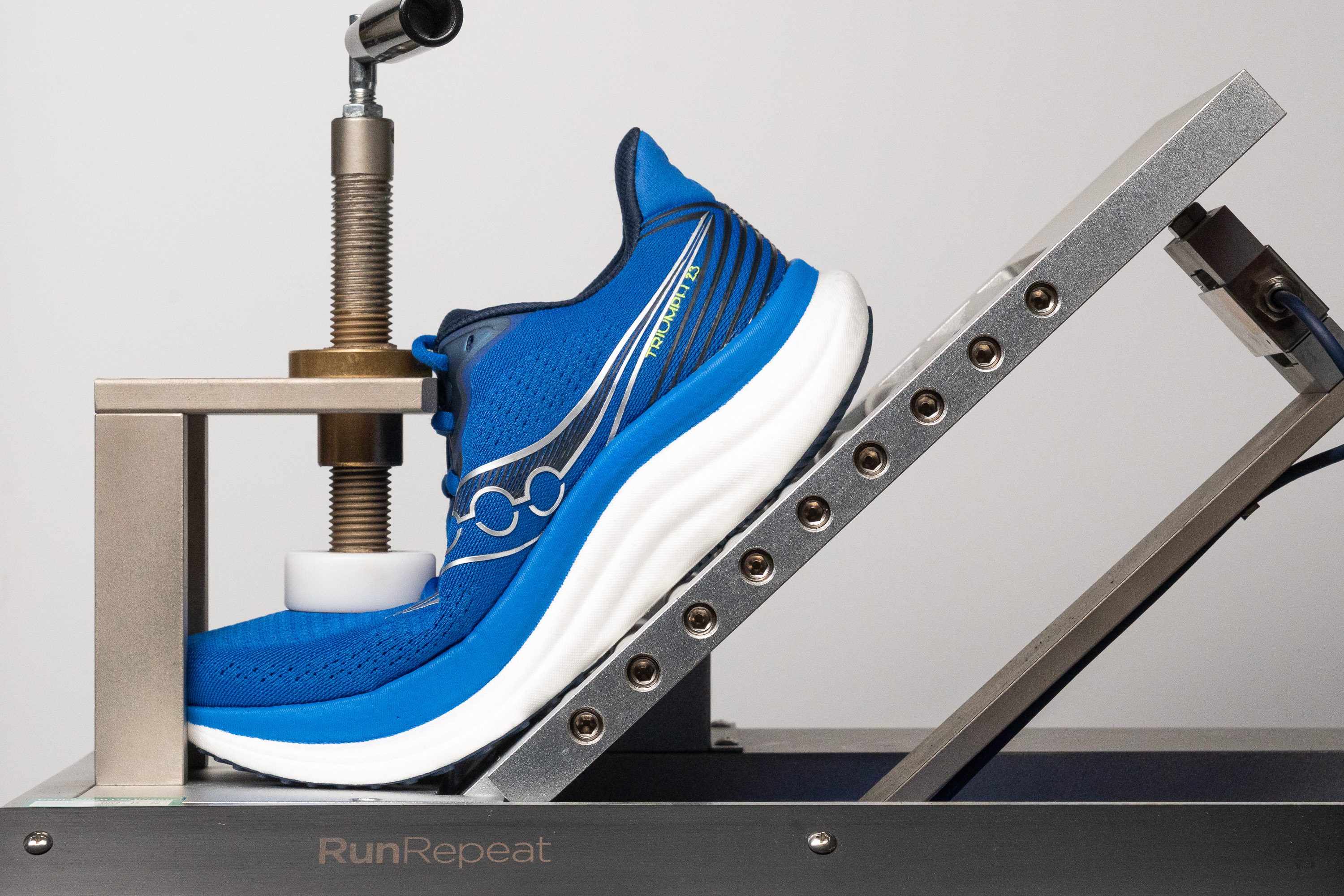
| Triumph 23 | 17.5N |
| Media | 15.3N |
Peso
Las Triumph 23 han mejorado bastante en cuanto a peso. En esta actualización, la báscula marcó 272 g, que es una reducción considerable de los 286 g de la versión anterior.
Personalmente, nosotros creemos que este cambio era muy necesario, y más teniendo en cuenta que esta última versión es más cara.
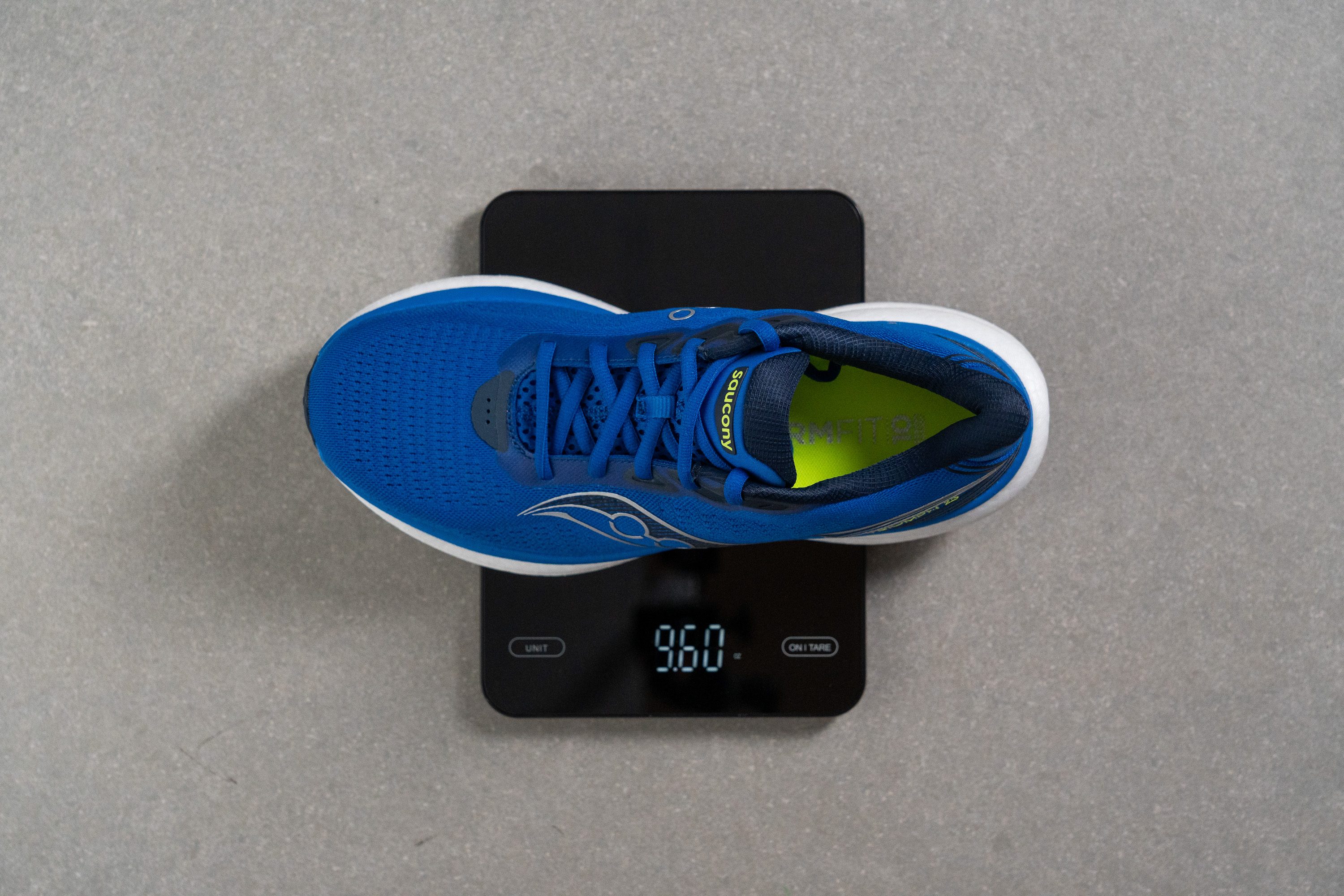
| Triumph 23 | 9.6 oz (272g) |
| Media | 9.3 oz (264g) |
Transpirabilidad
Si estás buscando unas zapatillas de running transpirables y vives en un sitio donde hace calor..., las Triumph 23 no son la mejor opción.
A ver, no podemos decir que sea terrible, porque un poquito transpirables... sí que son, pero el 3/5 que se llevaron en nuestra prueba nos dice que a lo mejor te dan mucho calor en verano. Eso sí, durante el resto del año no deberías tener problema.
Cuando pusimos un cacho del upper frente a la luz, esta casi no consiguió brillar a través de él. Esto nos dice que el flujo de aire estará bastante limitado, ya que estas zapatillas tienen una estructura gruesa que se centra más en ser cómoda que en ser transpirable.
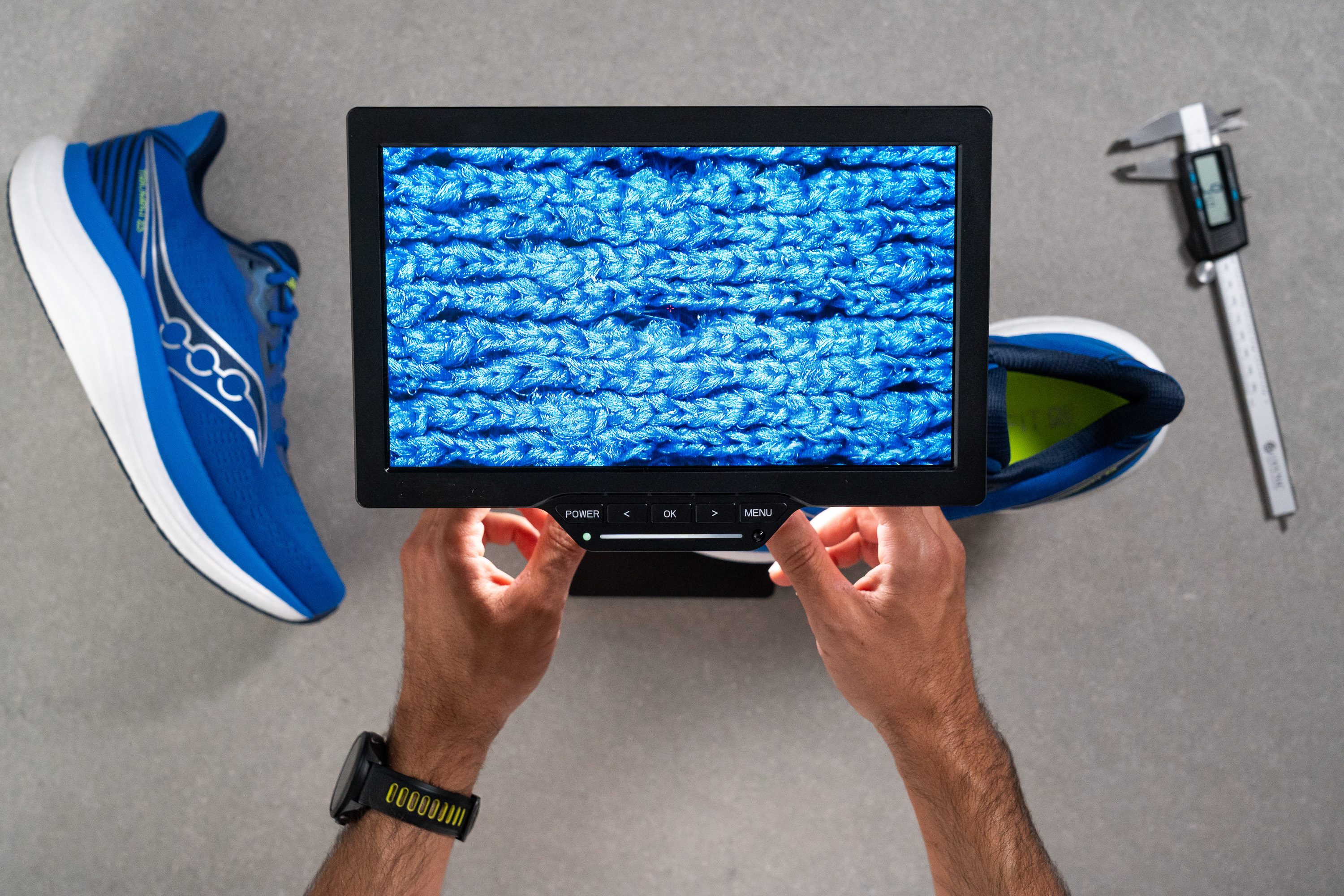
Gracias al microscopio, descubrimos por qué. Saucony utilizó un material muy tupido que, aunque se ve que tiene agujeritos, no deja que la mayor parte del aire ni entre ni salga.
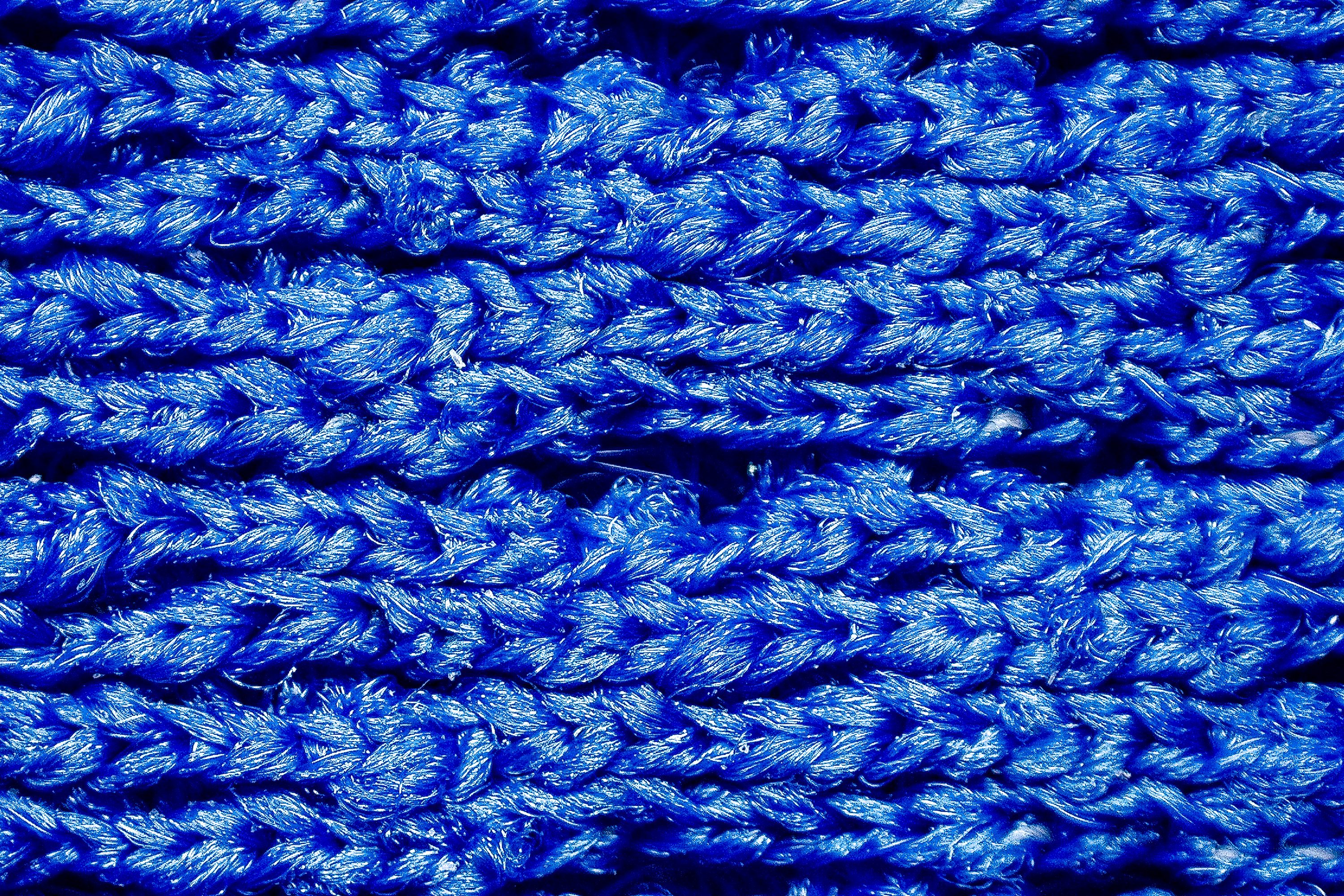
De hecho, esos agujeritos hasta están tapados con una capa interna que reduce el flujo de aire incluso más.
En el típico triángulo de transpirabilidad, durabilidad y comodidad, las marcas suelen tener que priorizar 2 de estas 3 características. En este caso, parece que Saucony ha intentado encontrar un equilibrio, aunque se inclina un poco más hacia la comodidad y la durabilidad.
| Triumph 23 | 3 |
| Media | 3.7 |
Estabilidad
Prueba de estabilidad lateral
Sabemos que la moda actual en las zapatillas de running es utilizar mediasuelas blanditas, pero las espumas más firmes también tienen ventajas evidentes, y una de ellas es que la pisada es más estable.
Pusimos a prueba a las Triumph 23 y descubrimos que su rendimiento es estupendo, gracias a la sujeción de su base ancha, a la estabilidad de sus paredes laterales, a la firmeza de la espuma PWRRUN PB y a su upper estructurado, que aunque reduce el flujo de aire proporciona una buena sujeción en los movimientos laterales.
Rigidez torsional
Cuando analizamos las Triumph 23, descubrimos que el diseño de su suela exterior mantiene la rigidez torsional en un nivel moderado. La verdad es que es algo impresionante si tenemos en cuenta lo altísima que es la mediasuela.
Nuestra evaluación manual hizo que se llevasen un 3/5, que es un resultado que está un poquito por debajo de la media. Incluso así, la verdad es que es ideal para las personas que pensaban usar estas zapatillas para hacer un poco de todo.
| Triumph 23 | 3 |
| Media | 3.5 |
Rigidez del contrafuerte del talón
Por otro, la rigidez del talón es muy alta. Saucony decidió sacrificar un poco de comodidad para ofrecer una mayor estabilidad en el retropié, aunque el grueso acolchado del talón se encarga de que tus pies estén encantados.
| Triumph 23 | 5 |
| Media | 2.9 |
Anchura de la mediasuela - antepié
Además de la espuma PWRRUN PB, el detalle que más ayuda con la estabilidad es lo ancha que es la mediasuela. Cuando la medimos en el antepié, nuestro calibre marcó 124,0 mm; las zapatillas cada vez se acercan más a los 130 mm en la talla 9 estadounidense de hombre que siempre compramos.
Los corredores que prefieren las zapatillas clásicas que se sienten ágiles y muy rápidas (y a los que no les gustan los pares grandotes que parecen tanques en los pies), probablemente no estén contentos con las Triumph 23. Pero... es que este es el rumbo que está siguiendo el mercado, y no hay muchas formas de hacer que unas zapatillas tan altas sean estables sin recurrir a este enfoque.
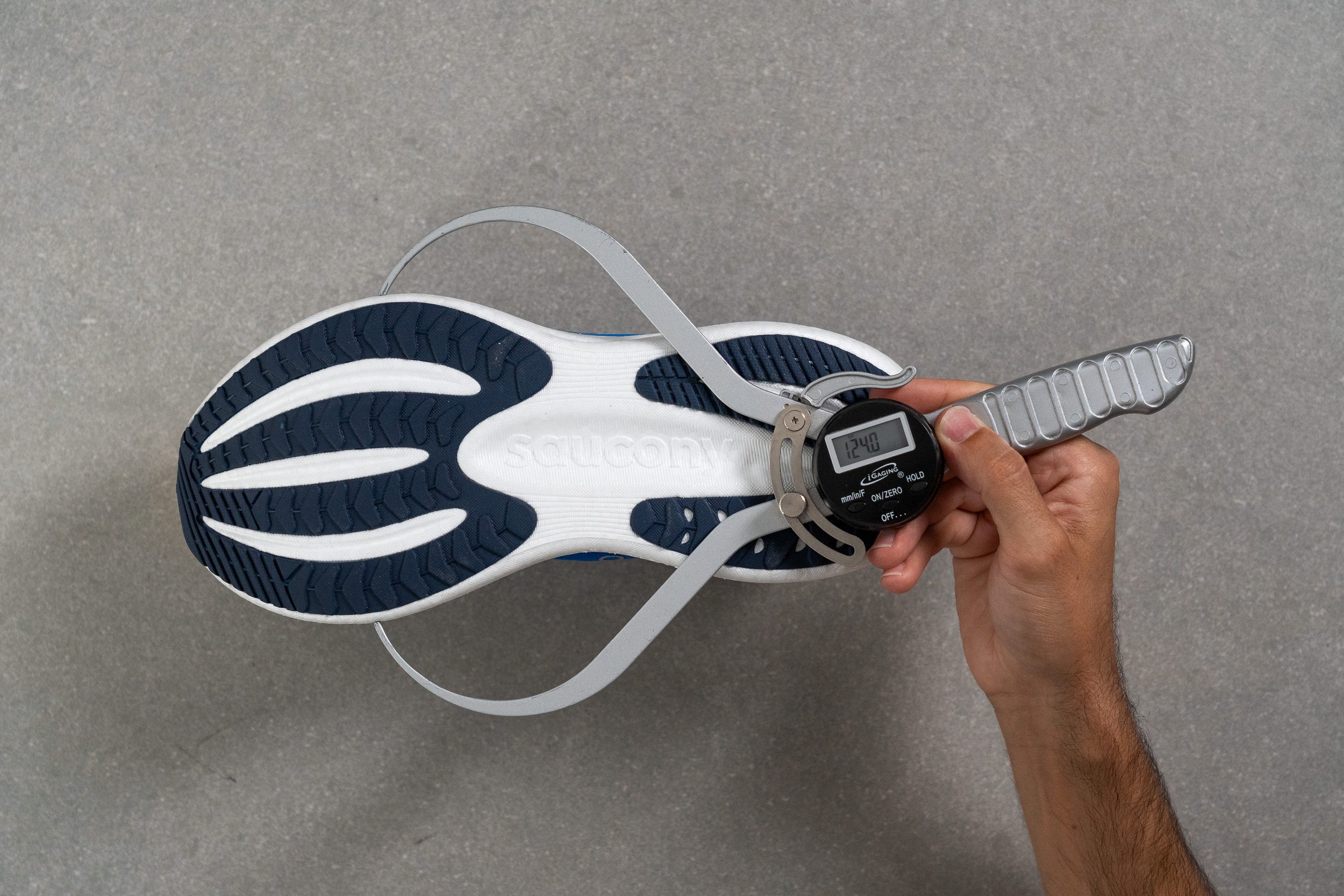
| Triumph 23 | 124.0 mm |
| Media | 114.4 mm |
Anchura de la mediasuela - talón
El talón también es muy ancho, con 98,9 mm, lo que nos recuerda al diseño de las zapatillas que son específicamente de estabilidad, como las Saucony Hurricane 24.
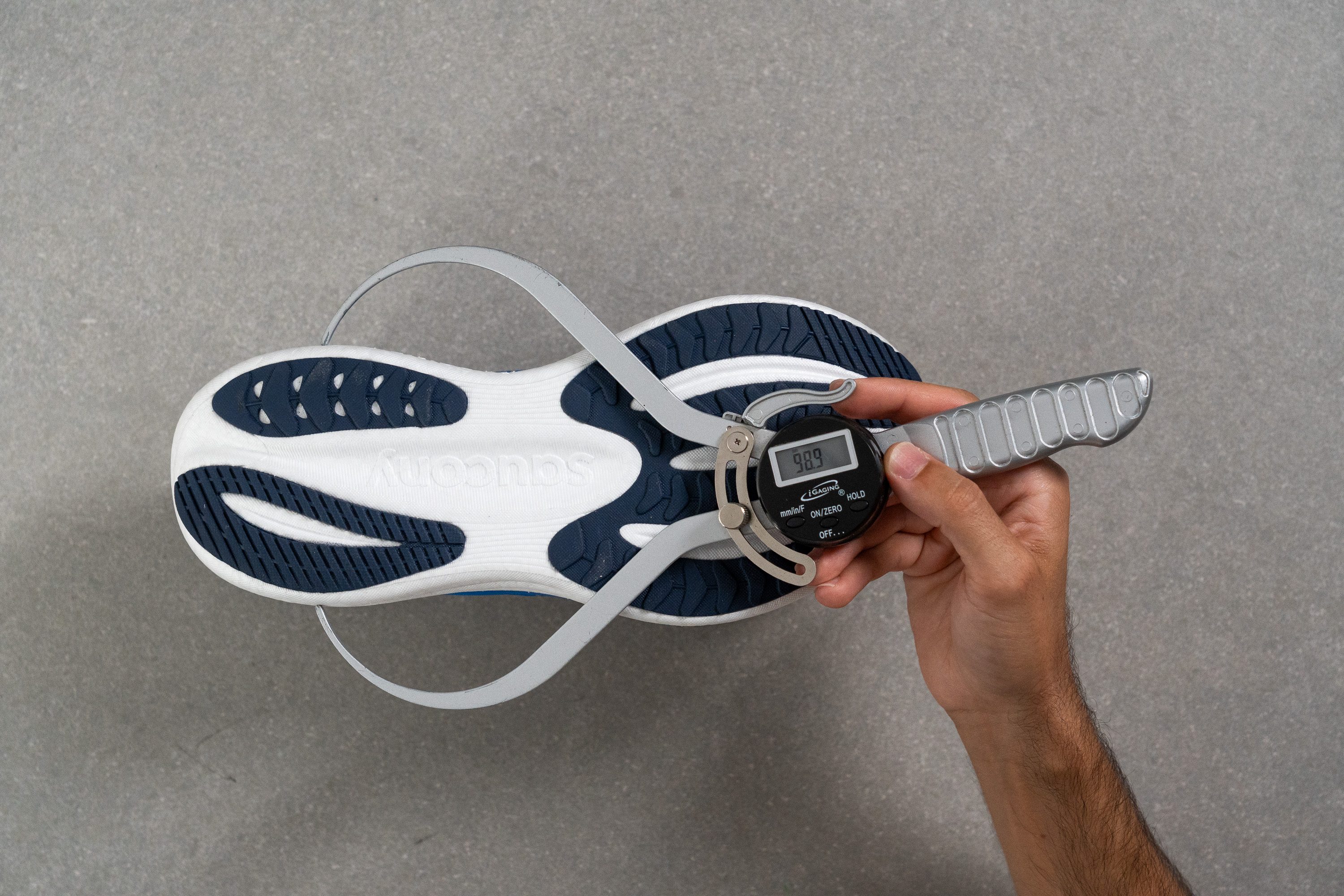
| Triumph 23 | 98.9 mm |
| Media | 90.7 mm |
Durabilidad
Durabilidad de la parte delantera
Una clara ventaja de que el upper no tenga agujeros grandes para el flujo de aire es que hay menos puntos débiles, que es algo que se suele traducir en una durabilidad sólida.
Cuando analizamos las Triumph 23, se llevaron un 3/5 en nuestra primera prueba de durabilidad, lo que confirma que tienen una estructura resistente.
| Triumph 23 | 3 |
| Media | 2.6 |
Durabilidad del acolchado del talón
La durabilidad del acolchado del talón es algo que, a muchos de nosotros, nos preocupa bastante.
Para analizarlo, le dimos caña a las Triumph 23 con un Dremel para simular el desgaste a largo plazo en cuestión de segundos. El acolchado aguantó muy bien, así que le dimos un 4/5.
| Triumph 23 | 4 |
| Media | 3.4 |
Durabilidad de la suela
Estamos muy contentos con la suela exterior de las Triumph 23. No les añade mucho peso, pero ofrecen un agarre estupendo incluso con tantas zonas de espuma expuesta. La verdad es que nos quedamos contentos con su durabilidad, ya que el desgaste fue de solo 0,7 mm de profundidad.
| Triumph 23 | 0.7 mm |
| Media | 1.1 mm |
Grosor de la suela
Saucony fue a lo seguro al utilizar una suela exterior de solo 3,3 mm de grosor. Teniendo en cuenta la sólida durabilidad del material (cosa que descubrimos gracias a los resultados de nuestra anterior prueba), no nos sorprendería en absoluto que la próxima versión utilizase una pieza más finita para reducir el peso.
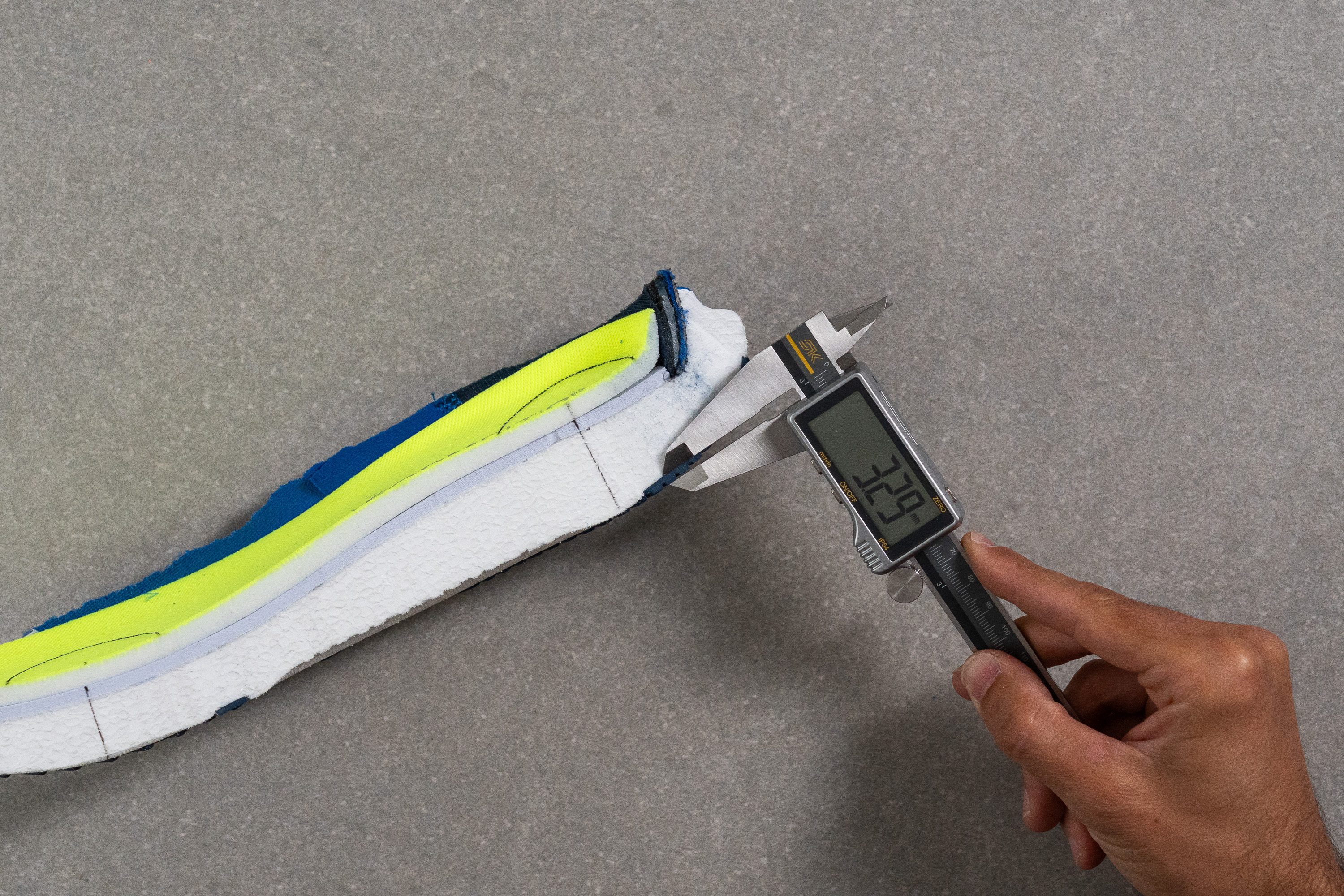
| Triumph 23 | 3.3 mm |
| Media | 3.2 mm |
Varios
Grosor de la plantilla
Este es uno de los secretos de las Saucony Triumph 23, así que atento. Resulta que su plantilla mide 6,3 mm, y no está hecha con la mítica EVA que utilizan muchas marcas, ya que a ese material le suele faltar rebote y se siente plano. Saucony utilizó este truco con su espuma PWRRUN+ (TPU) para las plantillas de modelos como las Omni 22, mejorando el retorno de energía y añadiendo una capa con mucho rebote.
En esta versión, se llama Super Responsie Sockliner, y está diseñada con una espuma blandita que hace que las zapatillas se sientan menos firmes que con una plantilla estándar. Sinceramente, creemos que hay muchas marcas que deberían pensarse bien si seguir utilizando plantillas tan baratas... y más cuando las combinan con espumas de Pebax o A-TPU de última generación.
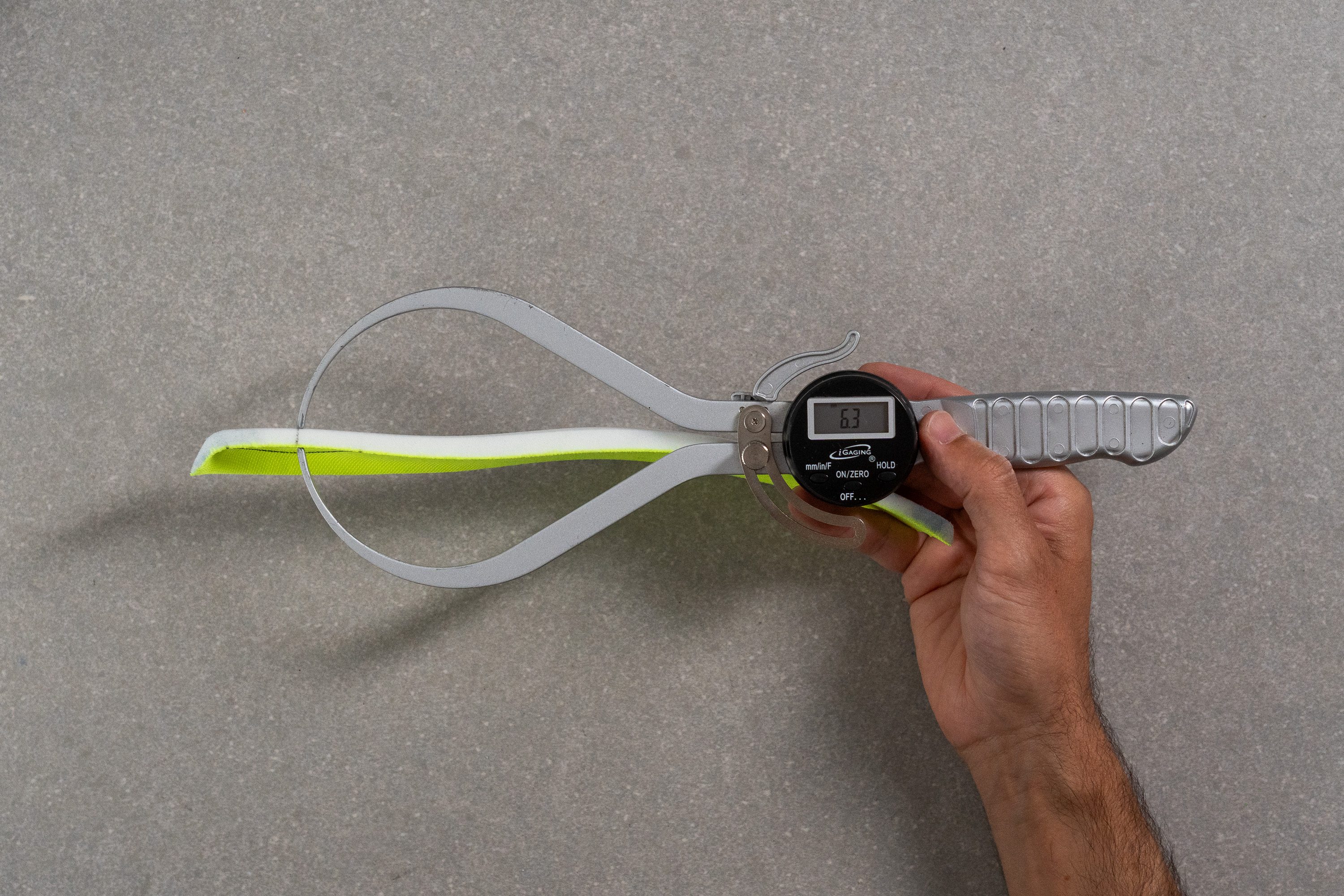
| Triumph 23 | 6.3 mm |
| Media | 4.5 mm |
Plantilla extraíble
No nos costó nada quitarles la plantilla a las Triumph 23. Aunque no es lo más recomendable, ya que viene cargada de energía y rebote, puedes cambiarla por otra más finita si necesitas más espacio dentro de las zapatillas.
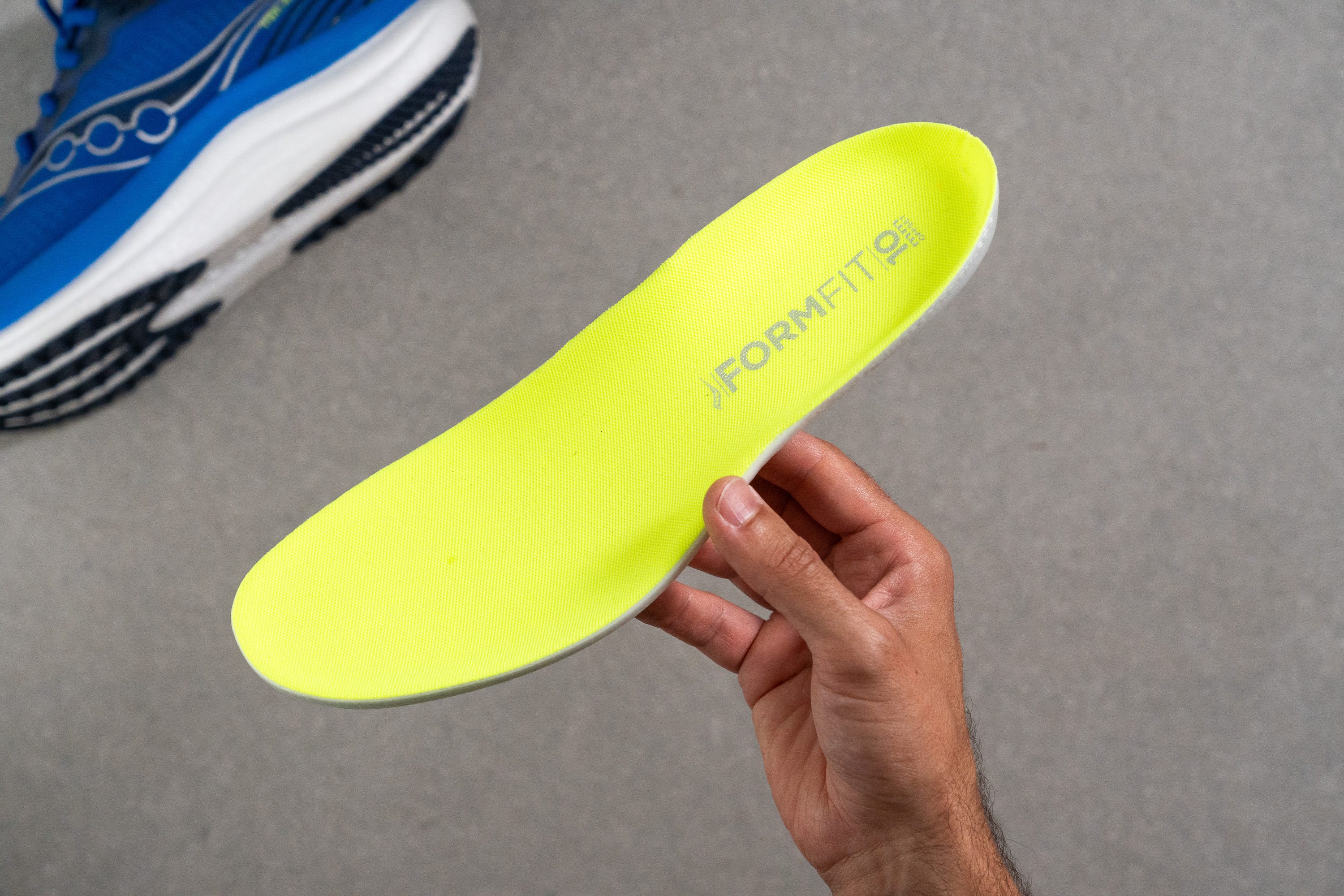
| Triumph 23 | Sí |
Rigidez de la mediasuela en frío (%)
Otra gran ventaja de la espuma PWRRUN PB es que está hecha de Pebax, así que rinde muy bien cuando bajan las temperaturas. En nuestra prueba, vimos que el cambio era solo del 8 %.
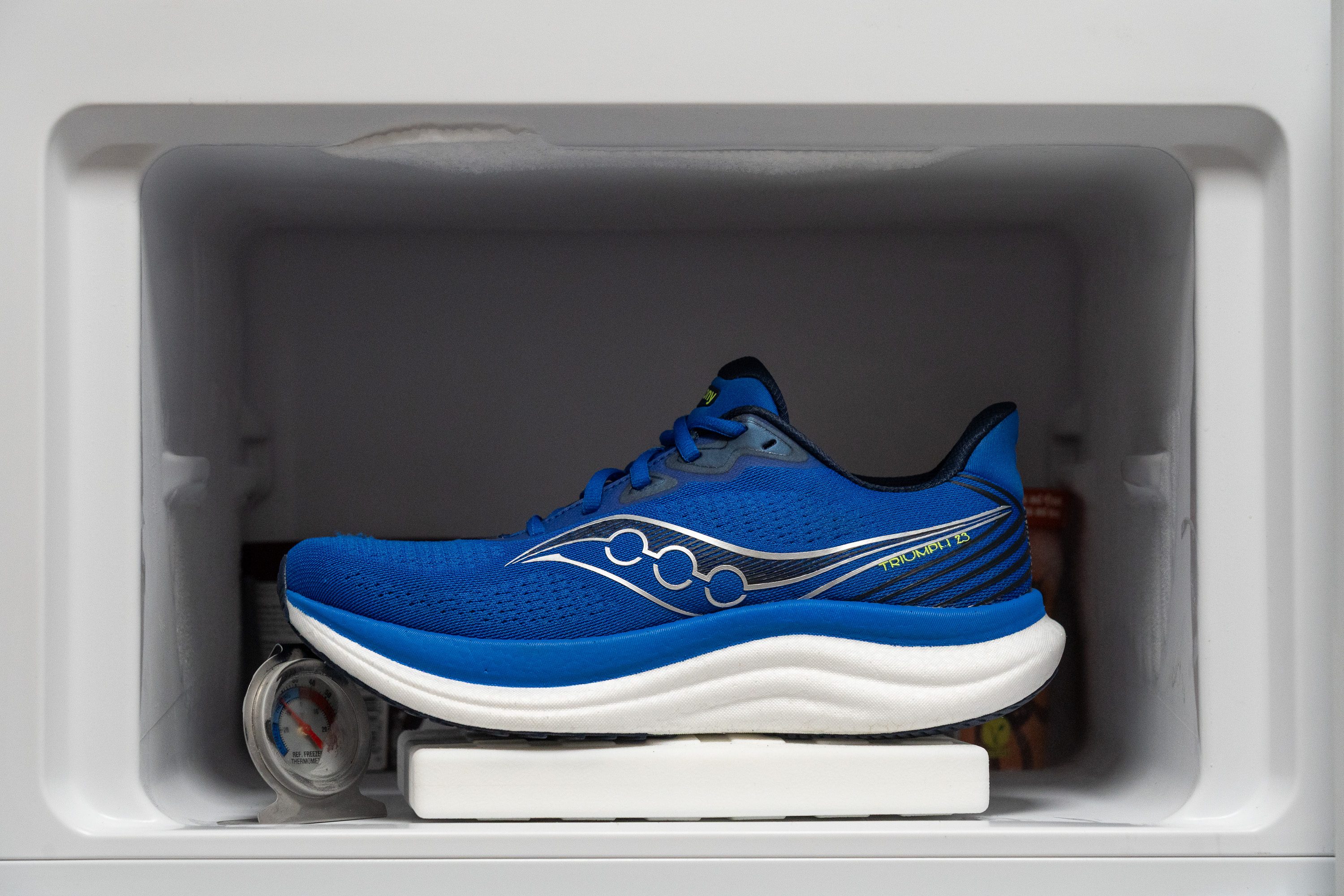
| Triumph 23 | 8% |
| Media | 24% |
Elementos reflectantes
Las Triumph 23 también tienen elementos reflectantes, aunque solo sea una pequeña línea en el talón, justo debajo de la costura. Es funcional, pero no podemos decir que sea el detalle más elegante del mundo.
| Triumph 23 | Sí |
Acolchado de la lengüeta
Los cordones de las Triumph 23 son estándar, con 5 ojales y 1 extra para poder hacerse el nudo del corredor. Los ojales de abajo están perforados directamente en la malla del upper sin ningún refuerzo adicional, mientras que los 2 de arriba tienen una capa sintética para mejorar la durabilidad y la sujeción.
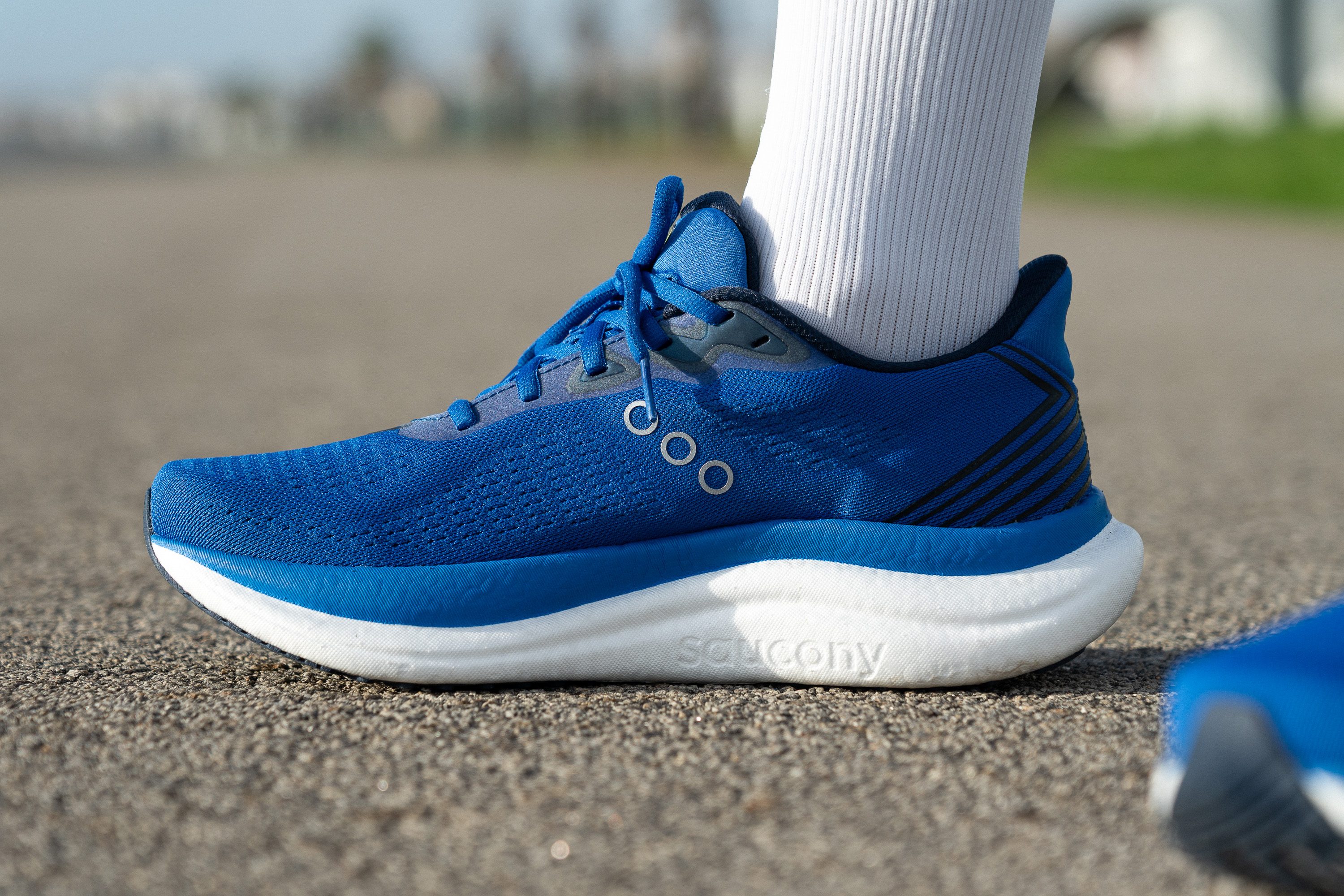
Saucony también decidió utilizar una lengüeta muy parecida a la de la versión 22, con un acolchado generoso (8,8 mm) que nos pareció comodísimo. La verdad es que apoyamos completamente esta decisión, sobre todo teniendo en cuenta que hay muchos corredores que utilizan este par en su día a día para viajar.
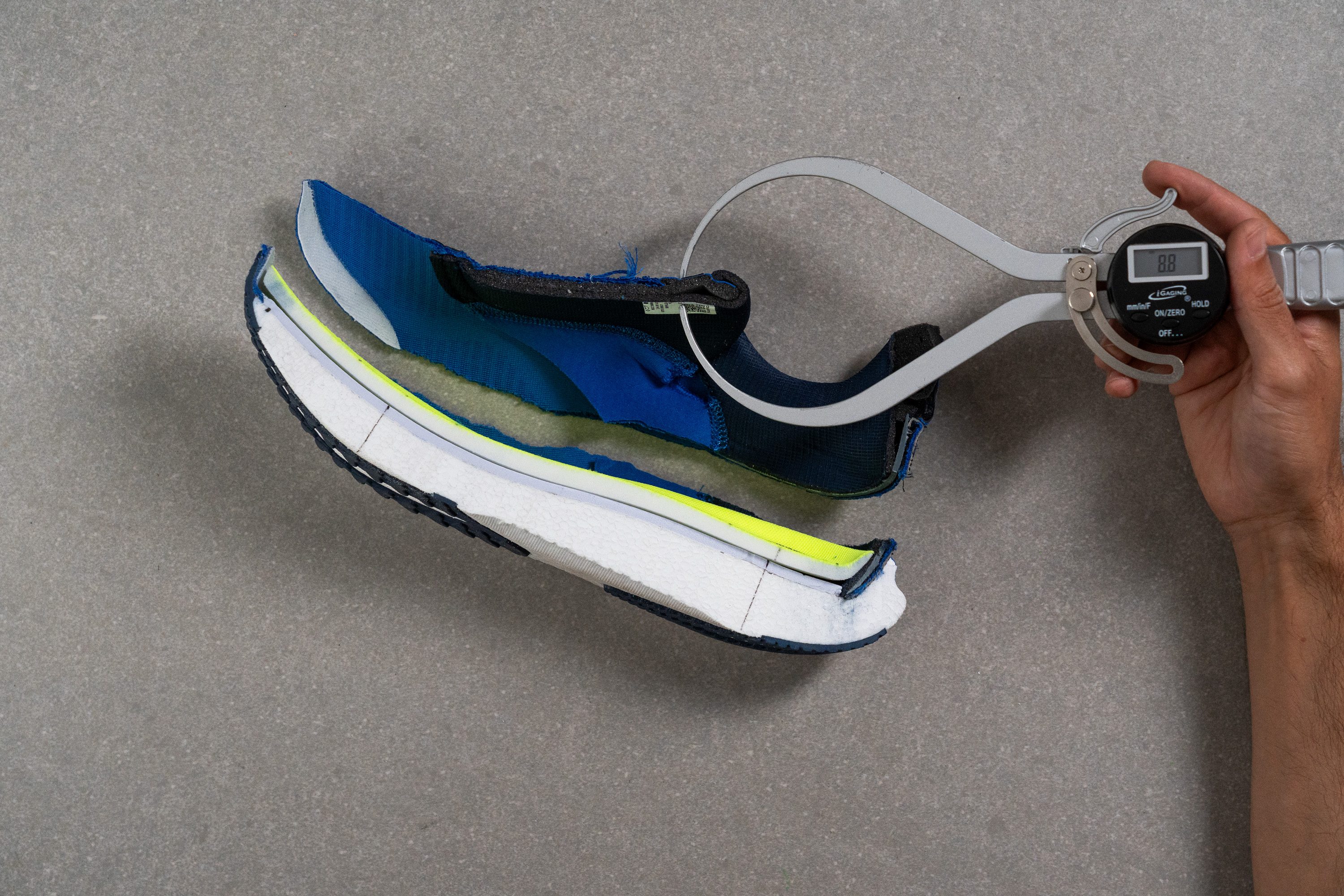
| Triumph 23 | 8.8 mm |
| Media | 5.8 mm |
Lengüeta: tipo de refuerzo
También estamos muy contentos de que Saucony utilizase una lengüeta semi reforzada para mejorar el cierre. No es un detalle que ofrezcan todos sus competidores, pero a nosotros nos parece algo básico para un modelo de entrenamiento premium.
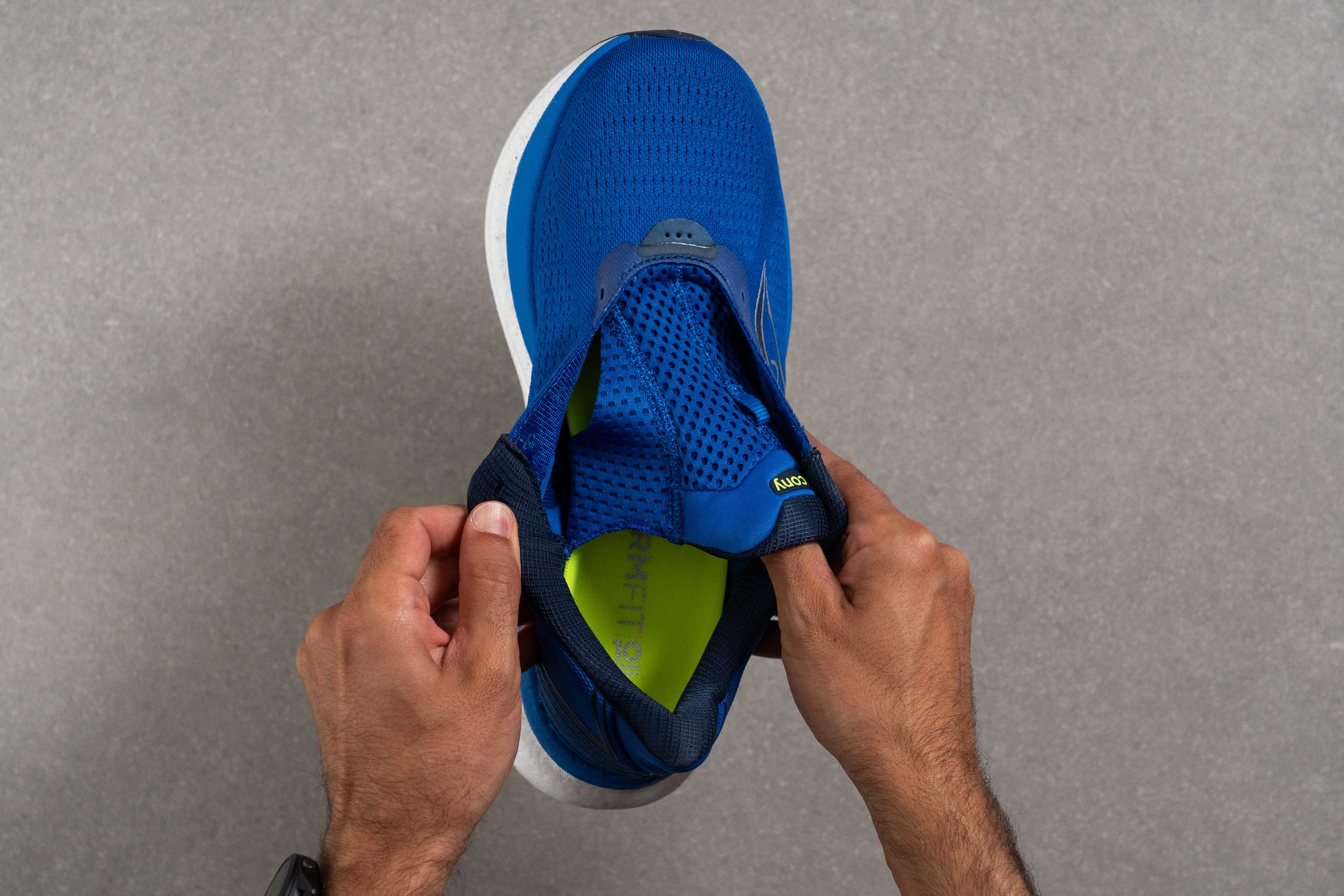
| Triumph 23 | Ambos lados (completo) |
Precio
Aquí venimos con malas noticias, y es que las Triumph 23 son un poquito más caras que la versión 22. Pero la pregunta es..., ¿es un aumento de precio justificado? ¡Nosotros no tenemos ninguna duda de que sí!
Ahora ya eres tú el que tiene que saber si estas zapatillas se adaptan a tus necesidades y a tu presupuesto, o no.
| Triumph 23 | $170 |
Tirador del talón
El diseño del talón es bastante simple, y además no tiene tirador. Pero bueno, si lo necesitas, puedes agarrar las zapatillas para calzarse sin problema.
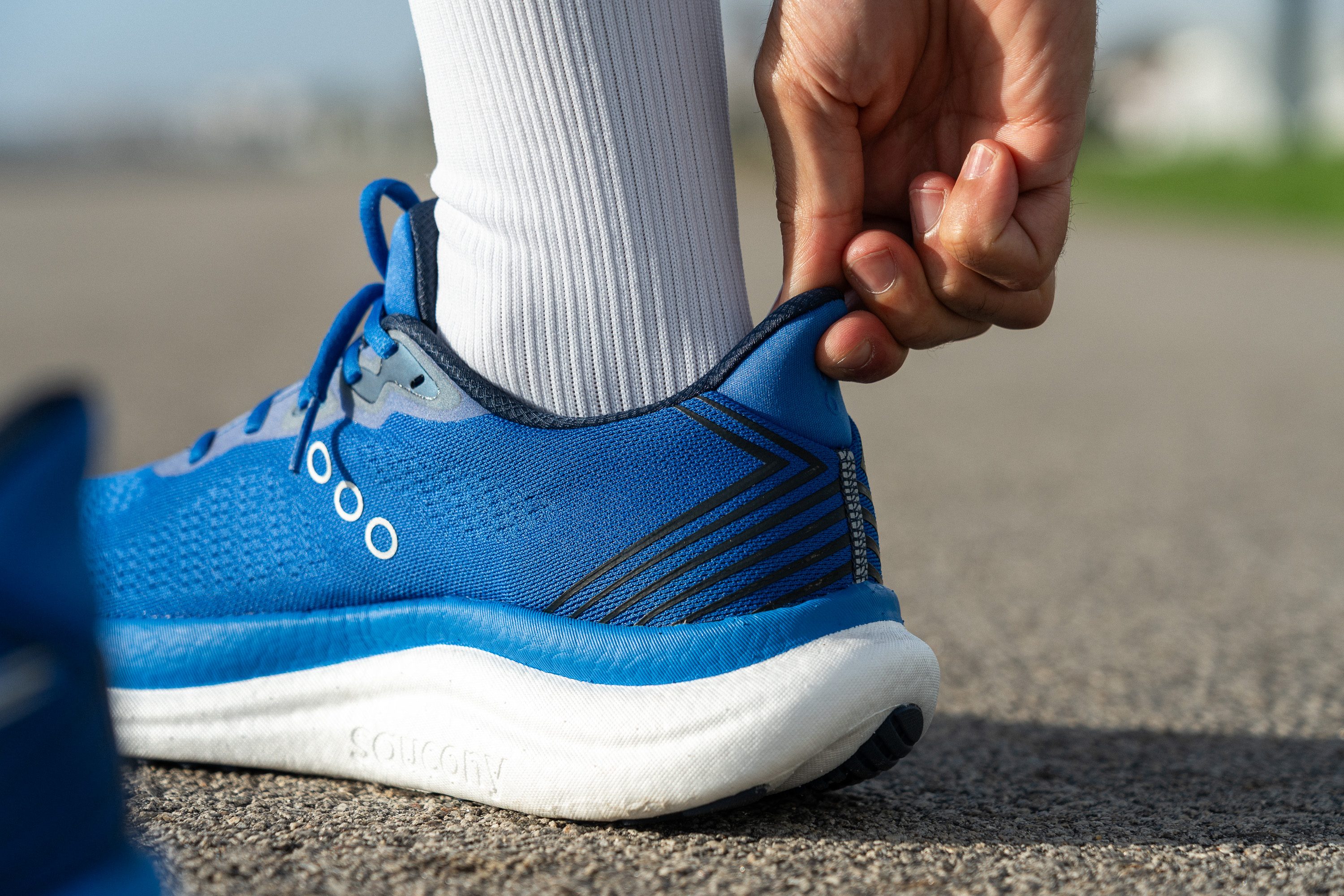
| Triumph 23 | Ninguno |

